Microsoft NEM4 N-Gage Bluetooth Enabled PCS Phone User Manual Part 2
Microsoft Mobile Oy N-Gage Bluetooth Enabled PCS Phone Part 2
Contents
- 1. Part 1
- 2. Part 2
Part 2
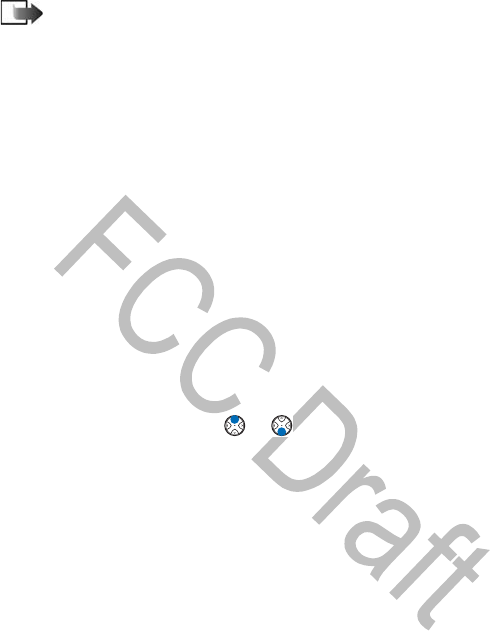
82 Copyright © Nokia 2003
Note: If you are using the POP3 protocol, e-mail messages are not
updated automatically in online mode. To see the newest e-mail
messages, you need to disconnect and then make a new connection to
your mailbox.
View e-mail messages offline
When you view e-mail messages offline, your game deck is not connected to the
remote mailbox.
To view e-mail messages offline, you must first retrieve e-mail messages from your
mailbox. After you have retrieved the e-mail messages to your game deck, select
Options > Disconnect to end the data connection.
You can continue reading the retrieved e-mail headings or the retrieved e-mail
messages offline. You can write new e-mail messages, reply to the retrieved e-mail
messages, and forward e-mail messages. You can set the e-mail messages to be
sent the next time you connect to the mailbox. When you open Mailbox the next
time and you want to view and read the e-mail messages offline, answer No to the
Connect to mailbox? query.
Retrieve e-mail messages
If you are offline, select Options > Connect to start a connection to a remote
mailbox.
The remote mailbox view is similar to the Inbox folder in Messaging. You can move
up and down in the list by pressing or . The following icons are used to
show the status of the e-mail:
—New e-mail (the arrow in the icon is pointing outwards). The content has not
been retrieved from the mailbox to your game deck (offline or online mode).
—New e-mail (arrow pointing inwards), the content has been retrieved from the
mailbox.
—E-mail messages that have been read.
—E-mail headings that have been read and the message content has been deleted
from the game deck.
1When you have an open connection to a remote mailbox, select Options >
Retrieve and one of the following:
New—to retrieve all new e-mail messages to your game deck.
Selected—to retrieve only the e-mail messages that have been marked. Use
the Mark/Unmark > Mark/Unmark commands to select messages one by one.
For information on marking items, see “Mark an item” on page 8.
All—to retrieve all messages from the mailbox.
2To cancel retrieving, press Cancel.
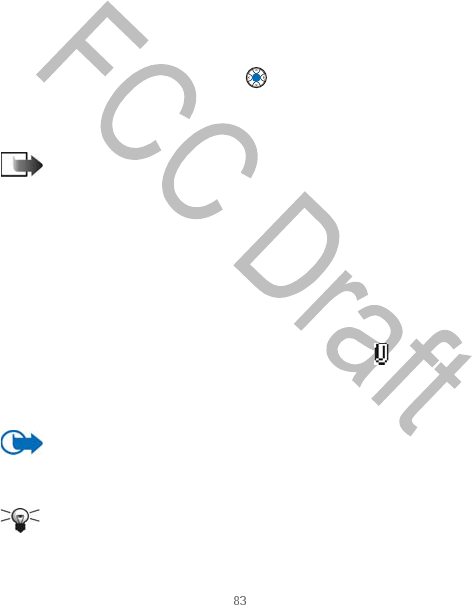
Nokia #### User Guide Copyright © Nokia 2003
Messaging
After you have retrieved the e-mail messages, you can continue viewing them
online.
3Select Options > Disconnect to close the connection and to view the e-mail
messages offline.
Copy e-mail messages to another folder
If you want to copy an e-mail from the remote mailbox to a folder under My
folders, select Options > Copy. Select a folder from the list and press OK.
Open e-mail messages
Options when viewing an e-mail message are Reply, Forward, Delete,
Attachments, Message details, Move to folder, Add to Contacts, Find, Help, and
Exit.
When you are viewing e-mail messages either in online or offline mode, scroll to
the e-mail you want to view and press to open it. If the e-mail message has
not been retrieved (arrow in the icon is pointing outwards), you are offline, and you
select Open, you will be asked if you want to retrieve this message from the
mailbox.
Note: The data connection is left open after e-mail has been retrieved. To
end the data connection, select Options > Disconnect.
Disconnect from mailbox
When you are online, select Options > Disconnect to end the data call or GPRS
connection to the remote mailbox. See “Data connection indicators” on page 6.
View e-mail attachments
Options in the Attachments view are Open, Retrieve, Save, Send, Delete, Help,
and Exit.
You can open a message that has the attachment indicator and select
Options > Attachments. In the Attachments view, you can retrieve, open, or save
attachments. You can also send attachments using a Bluetooth wireless
connection.
Important: E-mail attachments may contain viruses or otherwise be
harmful to your game deck or PC. Do not open any attachment if you are
not sure of the trustworthiness of the sender. For more information, see
“Certificate management” on page 48.
Tip: To save memory, you can remove attachments from an e-mail while
retaining them on the e-mail server. Select Options > Delete in the
Attachments view.

84 Copyright © Nokia 2003
RETRIEVE ATTACHMENTS
If an attachment has a dimmed indicator, it has not been retrieved to the game
deck. To retrieve the attachment, scroll to it and select Options > Retrieve.
Note: If your mailbox uses the IMAP 4 protocol, you can decide whether
to retrieve e-mail headings only, messages only, or messages and
attachments. With the POP3 protocol, the options are e-mail headings
only or messages and attachments. For further information, see page 82.
OPEN ATTACHMENTS
1In the Attachments view, scroll to an attachment and press to open it.
If you are online, the attachment is retrieved directly from the server and
opened in the corresponding application.
If you are offline, the game deck asks if you want to retrieve the attachment
to the game deck. If you answer Yes, a connection to the remote mailbox
begins.
2Press Back to return to the e-mail viewer.
Tip: Supported image formats are listed on page 63. To see a list of other
file formats supported by the Nokia N-Gage game deck, go to the product
information at www.n-gage.com.
SAVE ATTACHMENTS
To save an attachment, select Options > Save in the Attachments view. The
attachment is saved in the corresponding application. For example, sounds can be
saved in Recorder and text files (.TXT) in Notes.
Note: Attachments like images can be saved on the memory card, if the
memory card is defined as the memory store.
Delete e-mail messages
From the game deck message retained in remote mailbox, select Options >
Delete > Device only.
The game deck mirrors the e-mail headings in the remote mailbox. So, although
you delete the message content, the e-mail heading stays in your game deck. If you
want to remove the heading as well, you have to first delete the e-mail message
from your remote mailbox and then make a connection from your game deck to the
remote mailbox again to update the status.
From the game deck and remote mailbox, select Options > Delete > Device and
server.

Nokia #### User Guide Copyright © Nokia 2003
Messaging
If you are offline, the e-mail will be deleted first from your game deck. During the
next connection to the remote mailbox, it will be automatically deleted from the
remote mailbox. If you are using the POP3 protocol, messages marked to be deleted
are removed only after you have closed the connection to the remote mailbox.
Undelete e-mail messages
To cancel deleting an e-mail from both the game deck and server, scroll to an
e-mail that has been marked to be deleted during the next connection ( ), and
select Options > Undelete.
•OUTBOX
Outbox is a temporary storage place for messages that are waiting
to be sent.
Messages are placed in Outbox, for example, when your game deck is outside the
network coverage area. You can also schedule e-mail messages to be sent the next
time you connect to your remote mailbox.
Status of the messages in Outbox are as follows:
Sending—A connection is being made and the message is being sent.
Waiting/Queued—For example, if there are two similar types of messages in
Outbox, one of them is waiting until the first one is sent.
Resend at (time)—Sending has failed. The game deck will try to send the message
again after a time-out period. Press Send if you want to restart the sending
immediately.
Deferred—You can set documents to be on hold while they are in Outbox. Scroll to
a message that is being sent and select Options > Defer sending.
Failed—The maximum number of sending attempts has been reached. Sending has
failed. If you were trying to send a text message, open the message and check that
the Sending settings are correct.
• VIEW MESSAGES ON A SIM CARD
Before you can view SIM messages, you need to copy them to a folder in your game
deck.
1In Messaging, select Options > SIM messages.
2Select Options > Mark/Unmark > Mark or Mark all to mark messages.
3Select Options > Copy.
4Select a folder, press OK and go to the folder to view the messages.

86 Copyright © Nokia 2003
• CELL BROADCAST
In Messaging main view, select Options > Cell broadcast.
Options in cell broadcast are Open, Subscribe/Unsubscribe, Hotmark/
Unhotmark, Topic, Settings, Help, and Exit.
You can receive messages on various topics, such as weather or traffic conditions
from your service provider. For available topics and relevant topic numbers, contact
your service provider. In the main view you can see the following:
• The status of the topic: for new, subscribed messages and for new,
unsubscribed messages.
• The topic number, topic name, and whether it has been flagged ( ) for
follow-up. You will be notified when messages belonging to a flagged topic
have arrived.
Note: A packet data (GPRS) connection may prevent cell broadcast
reception. Contact your network operator for the correct GPRS settings.
For further information on the GPRS settings, see “Packet data (GPRS)” on
page 41.
• SERVICE COMMAND EDITOR
In Messaging, select Options > Service command.
You can send service requests, such as activation commands for network services
(also known as USSD commands Applicable to US?), to your service provider. For
more information, contact your service provider. To send a request do the
following:
• In the standby mode or when you have an active call, key in the command
numbers and press Send.
• If you need to enter letters as well as numbers, select Messaging > Options >
Service command.
• MESSAGE SETTINGS
The messaging settings have been divided into groups according to the different
message types. Scroll to the settings you want to edit and press .
Text message settings
Options when editing text message center settings are New msg. center, Edit,
Delete, Help, and Exit.

Nokia #### User Guide Copyright © Nokia 2003
Messaging
Go to Messaging and select Options > Settings > Text message to open the
following list of settings:
Message centers—Lists all the text message service centers that have been defined.
For a procedure to add a new text message center, see page 85.
Msg. center in use (message center in use)—Defines which message center is used
for delivering text messages and smart messages such as picture messages.
Receive report (delivery report)—When this network service is set to Yes, the status
of the sent message (Pending, Failed, Delivered) appears in the log. When set to
No, only the status Sent appears in the log.
Message validity—If the recipient of a message cannot be reached within the
validity period, the message is removed from the text message service center. Note
that the network must support this feature. Maximum time is the maximum
amount of time allowed by the network.
Message sent as—The options are Text, Fax, Paging, and E-mail. For further
information, contact your network operator.
Note: Change this option only if you are sure that your service center is
able to convert text messages into these other formats.
Preferred connection—You can send text messages using the normal GSM network
or using GPRS, if supported by the network. See “Packet data (GPRS)” on page 41.
Reply via same ctr. (network service)—By setting this option to Yes, if the recipient
replies to your message, the return message is sent using the same text message
service center number.
Use the following procedure to add a new text message center
1Open Message centers and select Options > New msg. center.
2Press , write a name for the service center, and press OK.
3Press .
4Press and write the number of the text message service center (Must be
defined). Press OK. You need the message center number to send text and
picture messages. You receive the number from your service provider.
To take the new settings into use, go back to the settings view. Scroll to Msg.
center in use, press , and select the new service center.
Multimedia messages settings
Go to Messaging and select Options > Settings > Multimedia message to open
the following list of settings:
Preferred connection (Must be defined)—Select which access point is used as the
preferred connection for the multimedia message center. See “Settings” on
page 73.
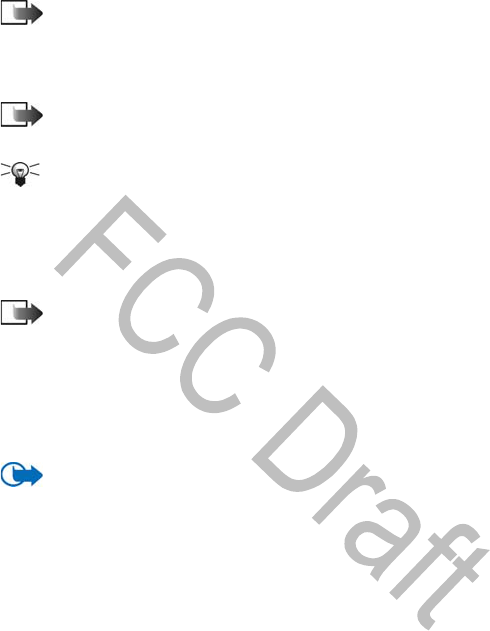
88 Copyright © Nokia 2003
Note: If you receive multimedia message settings in a smart message and
save them, the received settings are automatically used for the Preferred
connection. See “Receive smart messages” on page 79.
Secondary conn.—Select which access point is used as the secondary connection
for the multimedia message center.
Note: Both Preferred connection and Secondary conn. must have the
same Homepage setting pointing to the same multimedia service center.
Only the data connection is different.
Tip: If your preferred connection uses a packet data connection, you may
want to use high-speed data or data call for the secondary connection.
This way you are able to send and receive multimedia messages even
when you are not in a network that supports packet data. For further
information, please contact your network operator or service provider. See
also “Data connections and access points” on page 40.
Multimedia reception—Select from the following options:
Note: If the settings Only in home net. or Always on have been selected,
your game deck can make an active data call or GPRS connection without
your knowledge.
•Only in home net.—to receive multimedia messages only when you are in
your home network. When you are outside your home network,
multimedia message reception is turned off.
•Always on—to receive multimedia messages always.
•Off—to decline receiving multimedia messages or advertisements at all.
Important: When you are outside your home network, sending and
receiving multimedia messages may cost more.
On receiving msg.—Select from the following options:
•Retr. immediately—if you want the game deck to retrieve multimedia
messages instantly. If there are messages with Deferred status, they will
be retrieved as well.
•Defer retrieval—if you want the multimedia messaging center to save the
message to be retrieved later. To retrieve the message later, set On
receiving msg. to Retr. immediately.
•Decline message—if you want to decline multimedia messages. The
multimedia messaging center will delete the messages.
Allow anon. messages—Select No, if you want to decline messages coming from
an anonymous sender.
Receive adverts—Define whether you want to receive multimedia message
advertisements or not.

Nokia #### User Guide Copyright © Nokia 2003
Messaging
Reports—Set to Yes, if you want the status of the sent message (Pending, Failed,
Delivered) to be shown in the log.
Note: It might not be possible to receive a delivery report of a multimedia
message that has been sent to an e-mail address.
Deny report sending—Choose Yes, if you do not want your game deck to send
delivery reports of received multimedia messages.
Message validity—If the recipient of a message cannot be reached within the
validity period, the message is removed from the multimedia messaging center.
Note that the network must support this feature. Maximum time is the maximum
amount of time allowed by the network.
Image size—Define the size of the image in a multimedia message. The options are:
Small (max. of 160*120 pixels) and Large (max. 640X480 pixels).
Default speaker—Choose Loudspeaker or Handset, if you want the sounds in a
multimedia message to be played through the loudspeaker or the earpiece. For
more information, see “Loudspeaker” on page 10.
E-mail settings
Go to Messaging and select Options > Settings > E-mail.
Open Mailbox in use to select which mailbox you want to use.
Options when editing e-mail settings are Editing options, New mailbox, Delete,
Help, and Exit.
Mailboxes settings
Select Mailboxes to open a list of mailboxes that have been defined. If no
mailboxes have been defined, you will be prompted to do so. The following list of
settings appears:
Mailbox name—Write a descriptive name for the mailbox.
Access point in use (Must be defined)—The Internet Access Point (IAP) used for
the mailbox. Choose an IAP from the list. For more information on how to create
an IAP, see also “Connection settings” on page 40.
My mail address (Must be defined)—Write the e-mail address given to you by your
service provider. The address must contain the @ character. Replies to your
messages are sent to this address.
Outgoing mail server: (Must be defined)—Write the IP address or host name of
the computer that sends your e-mail.
Send message—Define how e-mail is sent from your game deck. Immediately—A
connection to the mailbox is started after you have selected Send. During next
conn.—E-mail is sent when you connect to your remote mailbox the next time.

90 Copyright © Nokia 2003
Send copy to self—Select Yes to save a copy of the e-mail to your remote mailbox
and to the address defined in My mail address.
Include signature—Select Yes if you want to attach a signature to your e-mail
messages and to start to write or edit a signature text.
User name:—Write your user name, given to you by your service provider.
Password:—Write your password. If you leave this field blank, you will be prompted
for the password when you try to connect to your remote mailbox.
Incoming mail server: (Must be defined)—The IP address or host name of the
computer that receives your e-mail.
Mailbox type:—Defines the e-mail protocol your remote mailbox service provider
recommends. The options are POP3 and IMAP4.
Note: This setting can be selected only once and cannot be changed if
you have saved or exited from the mailbox settings.
Security—Used with the POP3, IMAP4, and SMTP protocols to secure the
connection to the remote mailbox.
APOP secure login—Used with the POP3 protocol to encrypt the sending of
passwords to the remote e-mail server. Not shown if IMAP4 is selected for Mailbox
type.
Retrieve attachment (not shown if the e-mail protocol is set to POP3)—To retrieve
e-mail with or without attachments.
Retrieve headers—To limit the number of e-mail headers you want to retrieve to
your game deck. The options are All and User defined, which can only be used with
the IMAP4 protocol.
Service messages settings
When you go to Messaging and select Options > Settings > Service message, the
following list of settings opens:
Service messages—Choose whether or not you want to receive service messages.
Authentic. needed—Choose if you want to receive service messages only from
authorized sources.
Cell broadcast settings
Check with your service provider whether Cell broadcast is available and what the
available topics and related topic numbers are. Go to Messaging > Options >
Settings > Cell broadcast to change the settings:
Reception—On or Off

Nokia #### User Guide Copyright © Nokia 2003
Messaging
Language—All allows you to receive cell broadcast messages in all supported
languages. Selected allows you to choose in which languages you wish to receive
cell broadcast messages. If the language you want could not be found in the list,
select Other.
Topic detection—If you receive a message that does not belong to any of the
existing topics, Topic detection > On allows you to save the topic number
automatically. The topic number is saved to the topic list and shown without a
name. Choose Off if you do not want to save new topic numbers automatically.
Other folder settings
Go to Messaging and select Options > Settings > Other to open the following list
of settings:
Save sent messages—Choose if you want to save a copy of every text message,
multimedia message, or e-mail that you have sent to the Sent items folder.
No. of saved msgs.—Define how many sent messages will be saved to the Sent
items folder at a time. The default limit is 20 messages. When the limit is reached,
the oldest message is deleted.
Memory in use—Define memory used. Choices are game deck’s memory or memory
card.
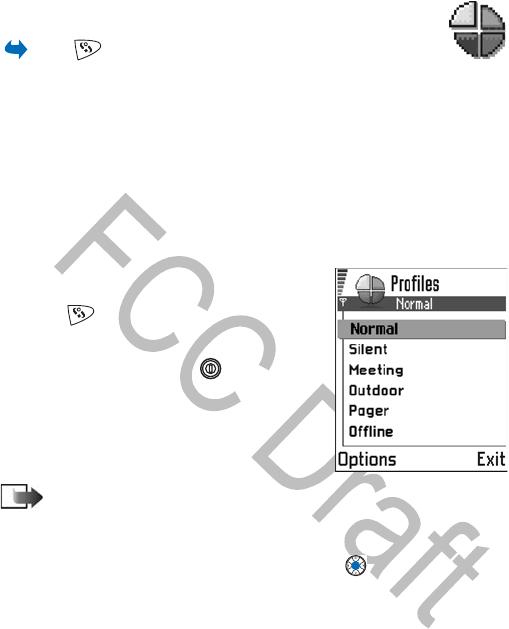
92 Copyright © Nokia 2003
11 Profiles
Press and go to Profiles.
In Profiles, you can adjust and customize the tones for different
events, environments, or caller groups. There are six preset profiles: Normal, Silent,
Meeting, Outdoor, Pager, and Offline, which you can customize to meet your
needs.
You can see the currently selected profile at the top of the display in the standby
mode. If the General profile is in use, only the current date appears.
The tones can be default ringing tones, tones created in Composer, tones received
in a message, or transferred to your game deck using a wireless technology, or a PC
connection, and then saved to your game deck.
•CHANGE PROFILES
1Press and go to Profiles..
2In the Profiles list, scroll to a profile and select
Options > Activate.
To change the profile, press in the standby
mode. Scroll to the profile you want to activate
and press OK
• CUSTOMIZE PROFILES
Note: For information on the offline
profile see “Offline profile” on page 93.
1To modify a profile, scroll to the profile in the Profiles list and select
Options > Personalize. A list of profile settings opens.
2Scroll to the setting you want to change and press to open the following
choices:
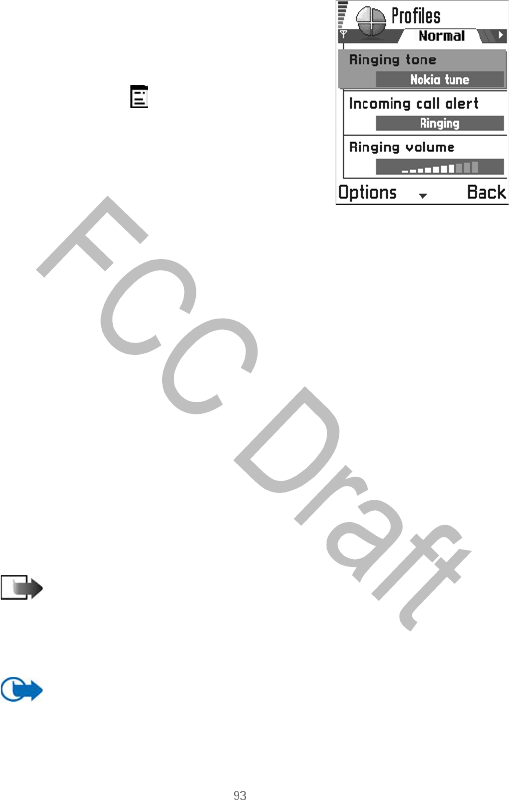
Nokia #### User Guide Copyright © Nokia 2003
Profiles
Ringing tone—To set the ringing tone for voice calls,
choose a ringing tone from the list. When you scroll
through the list, you can stop on a tone to listen to
it before you make your selection. Press any key to
stop the sound. If a memory card is used, tones
stored on it have the icon next to the tone name.
Ringing tones use shared memory. See “Shared
memory” on page 12.
You can change ringing tones in two places: Profiles
or Contacts. See “Add a ringing tone” on page 55.
Incoming call alert—When Ascending is selected,
the ringing volume starts from level one and
increases level by level to the set volume level.
Ringing volume—To set the volume level for the ringing and message alert tones.
Message alert tone—To set the tone for messages.
Vibrating alert—To set the game deck to vibrate at incoming calls and messages.
Keypad tones—To set the volume level for keypad tones.
Warning tones—The game deck sounds a warning tone, for example, when the
battery is running out of power.
Alert for—To set the game deck to ring only upon calls from phone numbers that
belong to a selected contact group. Phone calls coming from people outside the
selected group will have a silent alert. The choices are All calls and a list of contact
groups if you have created them. See “Create contact groups” on page 56.
Profile name—You can rename a profile and give it any name you want. The
General and Offline profiles cannot be renamed.
• OFFLINE PROFILE
Note: Your game deck must be switched on to use this function. Do not
switch the game deck on when wireless device, wireless technology, or
radio use is prohibited or when it may cause interference or danger.
Offline profile lets you use the game deck without connecting to the GSM wireless
network to play games, listen to music and the radio.
Important: In Offline profile you cannot make any calls, including
emergency calls, or use other features that require network coverage.
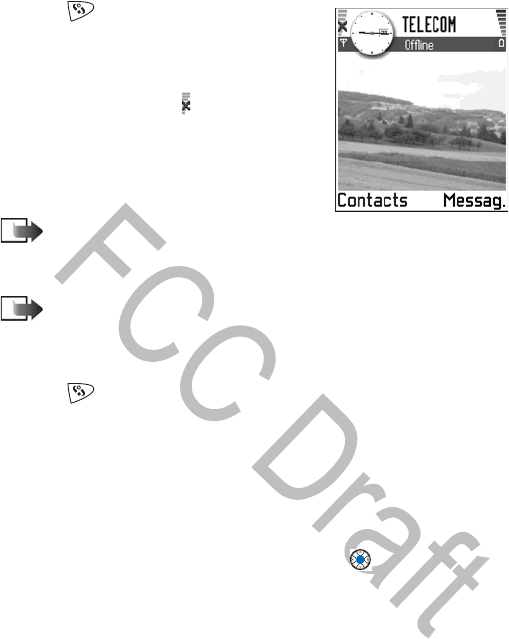
94 Copyright © Nokia 2003
1Press and go to Profiles.
2In the Profiles list, scroll to Offline and select
Options > Activate.
3Press Yes.
The game deck restarts and the GSM is turned
off, as indicated by the in the signal
strength indicator. All GSM wireless phone
signals to and from the device are prevented.
To open the list of available profiles, do a
short-press on the power. Then scroll to Offline
and select OK.
Note: If a Bluetooth connection was
turned off as a result of entering the offline profile you must re-enable
the connection manually. See “Bluetooth connection settings” on
page 120.
Note: In areas where mobile phone use is prohibited, wireless technology
and radio use may also be prohibited. Therefore, consult the relevant
authorities before using wireless technology or the radio.
Leave Offline profile
1Press and go to Profiles.
2In the Profiles list, scroll to a profile other than Offline, and select Options >
Activate.
3Press Yes.
The game deck restarts and it re-enables GSM wireless transmissions
(providing there is sufficient signal strength).
Customize Offline profile
1Scroll to Offline in the Profiles list and select Options > Personalize.
2Scroll to the setting you want to change and press to open the choices:
Ringing volume—To set the volume level for the message alert tones received
using a Bluetooth connection.
Message alert tone—To set the tone for messages received using a Bluetooth
connection.
Keypad tones—To set the volume level for keypad tones.
Warning tones—To set a warning tone sound, for example, when the battery
is running out of power.
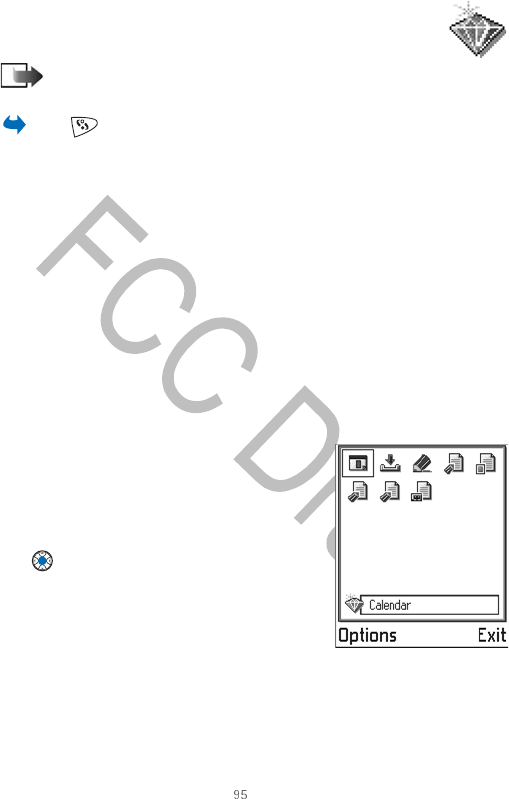
Nokia #### User Guide Copyright © Nokia 2003
Favorites
12 Favorites
Note: Your game deck must be switched on to use this
function. Do not switch the game deck on when wireless device use is
prohibited or when it may cause interference or danger.
Press and go to Extras > Favorites.
You can use Favorites to store shortcuts, links to your favorite images, video clips,
notes, recorder sound files, browser bookmarks, and saved browser pages.
Options in Favorites are Open, Edit shortcut name, Shortcut icon, Delete
shortcut, Move, List view/Grid view, Help, and Exit.
The default shortcuts are as follows:
• —opens the Notes editor
• —opens the Calendar with the current date selected
• —opens the Messaging Inbox
•ADD SHORTCUTS
Shortcuts can be added only from the individual applications. Not all applications
have this functionality. Shortcuts are automatically updated if you move the item
it is pointing to, for example moving an item from one folder to another
1Open the application and scroll to the item that
you want to add as a shortcut to Favorites.
2Select Options > Add to Favorites and press
OK.
Shortcut options are as follows:
•To open a shortcut, scroll to the icon and press
. The file is opened in the corresponding
application.
•To delete a shortcut, scroll to the shortcut you
want to remove and select Options > Delete
shortcut. Removing a shortcut does not affect
the file it is referring to.
•To change the shortcut heading, select Options > Edit shortcut name. Write
the new name. This change affects only the shortcut, not the file or item the
shortcut refers to.

96 Copyright © Nokia 2003
13 Calendar and To-do
Note: Your game deck must be switched on to use this function. Do not
switch the game deck on when wireless device use is prohibited or when
it may cause interference or danger.
Press and go to Calendar.
In Calendar, you can keep track of your appointments, meetings, birthdays,
anniversaries, and other events. You can also set a calendar alarm to remind you of
upcoming events.
Calendar uses shared memory. See “Shared memory” on page 12.
• CREATE CALENDAR ENTRIES
1Select Options > New entry and select one of the following:
Meeting to remind you of an appointment that has a specific date and time.
Memo to write a general entry for a day.
Anniversary to remind you of birthdays or special dates. Anniversary entries
are repeated every year.
2Fill in the fields (see “Calendar entry fields” on
page 97).
Use the controller key to move between fields.
Press to change between upper and
lower case.
3To save the entry, press Done.
Edit calendar entries
Options when editing a calendar entry are Delete,
Send, Help, and Exit.
1In the Day view, scroll to the entry and press
to open it.
2Edit the entry fields and press Done.
If you are editing a repeated entry, choose how you want the changes to take
effect:
All occurrences—all repeated entries are changed
This entry only—only the current entry will be changed.
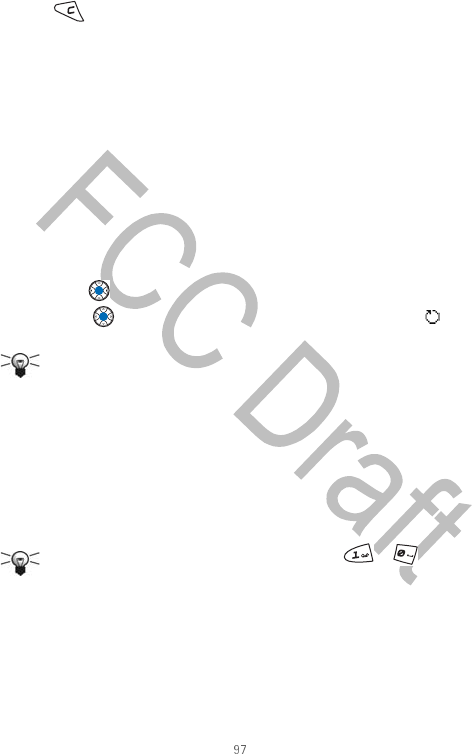
Nokia #### User Guide Copyright © Nokia 2003
Calendar and To-do
Delete calendar entries
In the Day view, scroll to the entry you want to delete and select Options > Delete
or press . Press OK to confirm.
If you are deleting a repeated entry, choose how you want the change to take
effect:
All occurrences—all repeated entries are deleted
This entry only—only the current entry will be deleted.
As as example, your weekly class has been canceled. You have set the calendar to
remind you every week. Choose This entry only and the calendar will remind you
again next week.
Calendar entry fields
Subject/Occasion—Write a description of the event.
Location—the place of a meeting, optional.
Start time, End time, Start date, and End date.
Alarm—Press to activate the fields for Alarm time and Alarm date.
Repeat—Press to change the entry to be repeating. Shown with in the day
view.
Tip: The repeat function is handy if you have a recurring event, a weekly
class, a monthly meeting, or a daily routine you need to remember.
Repeat until—You can set an ending date for the repeated entry.
Synchronization—If you select Private, after synchronization the calendar entry
can be seen only by you and it will not be shown to others with online access to
view the calendar. This is useful when, for example, you synchronize your calendar
with a calendar on a compatible computer at work. If you select Public, the
calendar entry is shown to others who have access to view your calendar online. If
you select None, the calendar entry will not be copied to your PC when you
synchronize your calendar.
Tip: To write a calendar entry, press any key ( —) in any
calendar view. A Meeting entry is opened and the characters you keyed in
are added to the Subject field.
Calendar views
Options in the different calendar views are Open, New entry, Week view/
Month view, Delete, Go to date, Send, Settings, Help, and Exit.

98 Copyright © Nokia 2003
MONTH VIEW
Synchronization icons in the month view are as
follows:
•Private
•Public
•None
• the day has multiple entries
In the Month view, one row equals one week. The
current date is underlined. Dates that have calendar
entries are marked with a small triangle in the right
bottom corner. There is a frame around the currently
selected date.
To open the Day view, scroll to the date you want to
open and press .
To go to a certain date, select Options > Go to date. Write the date and press OK.
Tip: If you press in month, week, or day views, today’s date is
automatically highlighted.
Calendar entry icons in Day and Week views:
•Meeting
•Memo
•Anniversary
WEEK VIEW
In the Week view, the calendar entries for the
selected week are shown in seven day boxes. The
current day of the week is underlined. Memos and
Anniversaries are placed before 8:00 a.m. Meeting
entries are marked with colored bars according to
starting and ending times.
To view or edit an entry, scroll to the cell that has an
entry and press to open the Day view, then
scroll to the entry and press to open it.
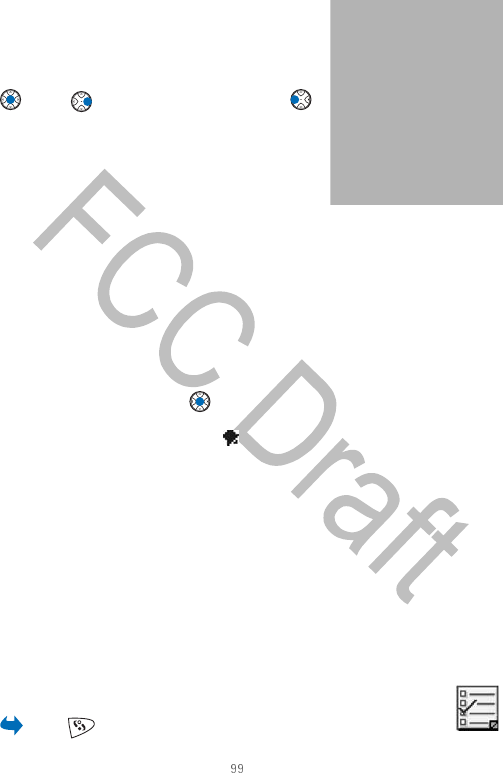
Nokia #### User Guide Copyright © Nokia 2003
Calendar and To-do
DAY VIEW
In the Day view, you can see the calendar entries for
the selected day. The entries are grouped according
to their starting time. Memos and anniversaries are
placed before 8:00 a.m.
To open an entry for editing, scroll to it and press
. Press to go to the next day or press
to go to the previous day.
Calendar view settings
Select Options > Settings and select one of the
following:
Default view—To select the view that appears first
when you open Calendar.
Week starts on—To change the starting day of the week.
Week view title—To change the title of the Week view to be the week number or
the week dates.
• SET CALENDAR ALARMS
• Create a new meeting or anniversary entry, or open a previously created entry.
• Scroll to Alarm and press to open the Alarm time and Alarm date fields.
• Set the alarm time and date.
• Press Done. An alarm indicator appears next to the entry in the Day view.
Stop a calendar alarm
The alarm duration is one minute. When the alarm time expires, press Stop to end
the calendar alarm. If you press any other key, the alarm is set to snooze.
• SEND CALENDAR ENTRIES
In the Day view, scroll to the entry you want to send and select Options > Send.
Then select the method, the choices are Via text message, Via e-mail (available
only if the correct e-mail settings are in place), and Via Bluetooth. For further
information, see “Messaging” on page 66, and “Send data” on page 121.
•TO-DO
Press and go to Extras > To-do.
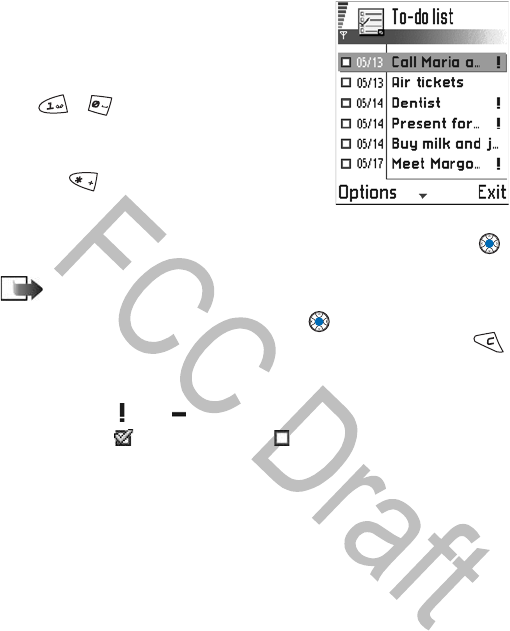
100 Copyright © Nokia 2003
In To-do you can keep a list of tasks that you need
to do.
The To-do list uses shared memory. See “Shared
memory” on page 12.
1To start to write a to-do note, press any key
(—).
The editor opens and the cursor blinks after the
letters you have keyed in.
2Write the task in the Subject field.
Press to add special characters.
3To set the due date for the task, scroll to the
Due date field and key in a date.
4To set a priority for the to-do note, scroll to the Priority field and press .
5To save the to-do note, press Done.
Note: If you remove all characters and press Done, the previously saved
note will be deleted.
6To open a to-do note, scroll to it and press .
7To delete a to-do note, scroll to it and select Options > Delete or press .
8To mark a to-do note as completed, scroll to it and select Options > Mark
as done.
9To restore a to-do note, select Options > Mark as not done.
Priority icons: —High, —Low, and (no icon)—Normal.
Status icons: —task completed and —not completed.
• DATA IMPORT
You can move calendar, contacts and to-do data from many different Nokia phones
to your game deck using the PC Suite for Nokia N-Gage game deck Data Import
application. Instructions for using the application can be found in the PC Suite
online help.
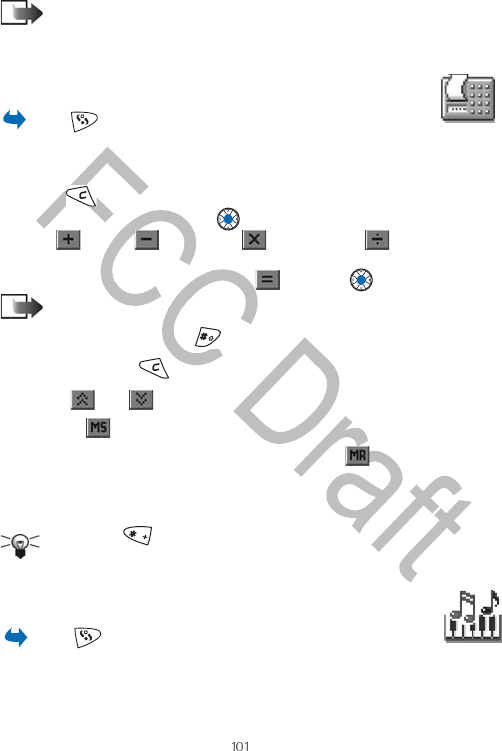
Nokia #### User Guide Copyright © Nokia 2003
Extras
14 Extras
Note: Your game deck must be switched on to use the functions in the
Extras folder. Do not switch the game deck on when wireless device use
is prohibited or when it may cause interference or danger.
• CALCULATOR
Press and go to Extras > Calculator.
Options in Calculator are Last result, Memory, Clear screen, Help, and Exit.
1Enter the first number of your calculation.
Press to erase a mistake in the number.
2Scroll to a function and press to select it.
Use to add, to subtract, to multiply, or to divide.
3Enter the second number.
4To execute the calculation, scroll to and press .
Note: The calculator has limited accuracy and rounding errors may occur,
especially in long divisions.
• To add a decimal, press .
• Press and hold to clear the result of the previous calculation.
•Use and to view previous calculations and move in the sheet.
•Select to save a number to the memory, indicated by M.
• To retrieve the number from the memory, select .
• To clear a number in memory, select Options > Memory >Clear screen.
• To retrieve the result of the last calculation, select Options > Last result.
Tip: Press repeatedly to scroll the functions. You can see the
selection change between the functions.
• COMPOSER
Press and go to Media > Composer.
Composer allows you to create your own, customized ringing tones. Note that it is
not possible to edit a default ringing tone.
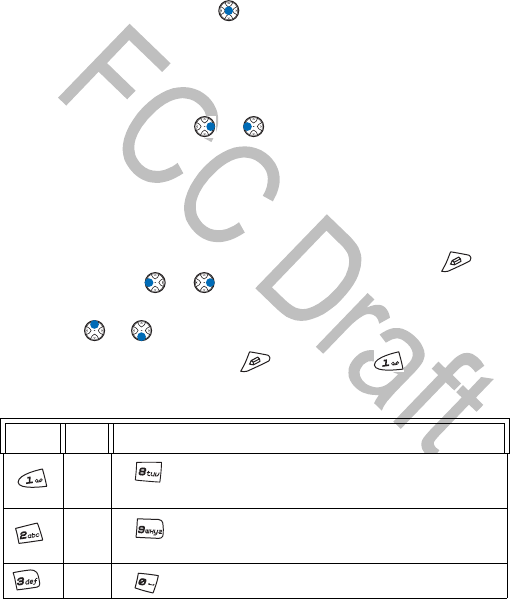
102 Copyright © Nokia 2003
Options in Composer are Open, New tone, Delete, Mark/Unmark, Rename,
Duplicate Help, and Exit.
1Select Options > New tone to open the editor and to start composing.
Options when composing are Play, Insert symbol, Style, Tempo, Volume, Help,
and Exit.
• Select Options > Insert symbol to open a list of notes and rests, or use the
keys to add notes and rests. See the table later in this section. The default
duration a quarter note.
• To listen to the tone, press or select Options > Play. To stop playing,
press Stop.
• To adjust the volume select Options > Volume before you start to play the
tone.
• To adjust the tempo, select Options > Tempo. To increase or decrease the
tempo gradually, press or , respectively.
You can set the tempo to any number between 50 and 250 beats per
minute. The default tempo is 160 beats per minute.
• To apply different playing styles, select Options > Style > Legato (notes
played in a smooth and even manner) or Staccato (notes played separately
to produce short, sharp sounds).
• To select many notes or rests at the same time, press and hold and
press and hold or at the same time.
• To move notes up or down on the staff by a half step, scroll to the note and
press or .
• To produce C#, press and hold together with .
2Press Back to save.
Keys Note Key and function
c Shortens the duration of the selected notes or rests
in steps.
d Lengthens the duration of the selected notes/rests
in steps.
e Inserts a rest.
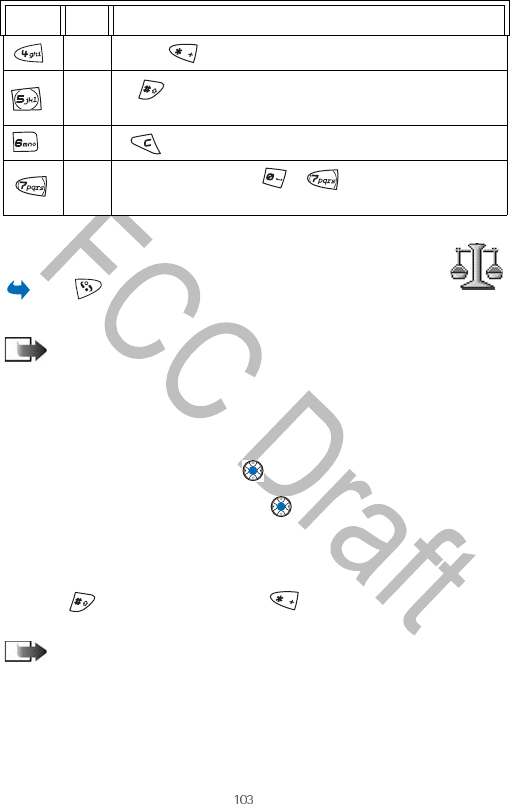
Nokia #### User Guide Copyright © Nokia 2003
Extras
•CONVERTER
Press and go to Extras > Converter.
In Converter, you can convert measures (such as Length) from one unit to another.
Note: The Converter has limited accuracy, and rounding errors may occur.
Convert units
Options in Converter are Select unit / Change currency, Conversion type,
Currency rates, Help, and Exit.
1Scroll to the Type field and press to open a list of measures.
2Scroll to the measure you want to use and press OK.
3Scroll to the first Unit field and press to open a list of available units.
Select the unit from which you want to convert and press OK.
Scroll to the next Unit field and select the unit to which you want to convert.
4Scroll to the first Amount field and key in the value you want to convert.
The other Amount field changes automatically to show the converted value.
Press to add a decimal and press for the +,—(for temperature), and
E (exponent) symbols.
Note: The conversion order changes if you write a value in the second
Amount field. The result appears in the first Amount field.
Choose currency and set exchange rate
Before you can make currency conversions, you need to choose a base currency and
add exchange rates.
fPress to open a list of notes and rests.
g Switches octaves, all selected notes or rests are
moved to the next octave.
a Deletes selected notes.
bA long press of keys — produces a dotted
(lengthened) note or rest or shortens a lengthened note.
Keys Note Key and function
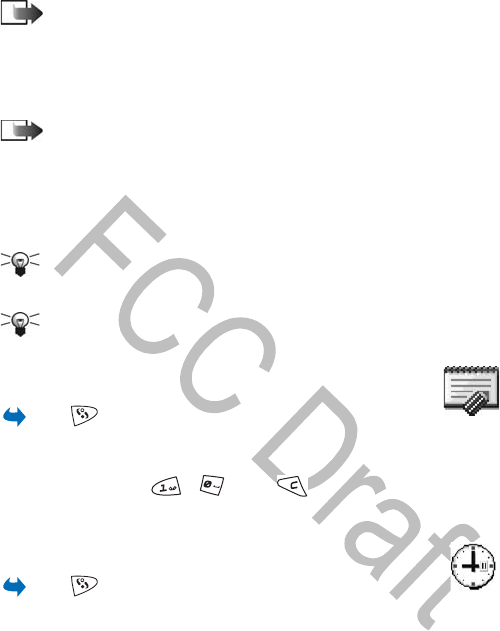
104 Copyright © Nokia 2003
Note: The rate of the base currency is always 1. The base currency
determines the conversion rates of the other currencies.
1Select Currency as the measure type and select Options > Currency rates.
A list of currencies opens and you can see the current base currency at the top.
2To change the base currency, scroll to the currency, and select Options > Set
as base curr.
Note: When you change the base currency, all previously set exchange
rates are set to 0 and you need to key in new rates.
3Add exchange rates, scroll to the currency, and key in a new rate. (The new rate
indicates how many units of the currency equal one unit of the base currency
you have selected.)
4After you have inserted all the needed exchange rates, you can make currency
conversions. See “Convert units” on page 103.
Tip: For example, if you set the euro (EUR) as the base currency, and a
dollar (USD) is currently 1.146 euros, you would key in 1.146 as the
exchange rate for the USD.
Tip: To rename a currency, go to Currency rates, scroll to the currency, and
select Options > Rename currency.
•NOTES
Press and go to Extras > Notes.
You can link notes to Favorites and send them to other compatible devices. Plain
text files (TXT format) you receive can be saved to Notes.
To start to write, press ( —). Press to clear letters. Press Done to
save.
•CLOCK
Press and go to Extras > Clock.
Options in Clock are Set alarm, Reset alarm, Remove alarm, Settings, Help, and
Exit.
Settings
To change the time or date, select Options > Settings in Clock. To change the clock
shown in the standby mode, scroll down in the Date and time settings and select
Clock type > Analog or Digital.
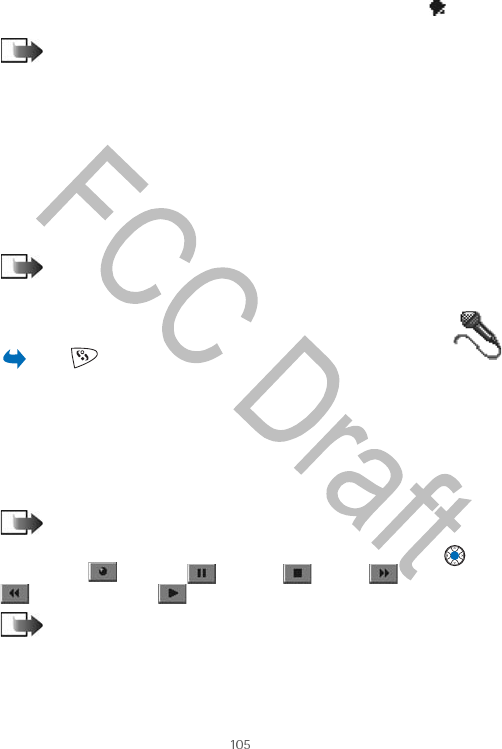
Nokia #### User Guide Copyright © Nokia 2003
Extras
Set alarm
1To set a new alarm, select Options > Set alarm.
2Enter the alarm time and press OK. When the alarm is active, the indicator
appears.
Note: The alarm clock works even if the game deck is switched off.
To cancel an alarm, go to clock and select Options > Remove alarm.
To turn off an alarm, press Stop.
When the alarm tone sounds, press any key or Snooze to stop the alarm for five
minutes, after which it will resume. You can do this a maximum of five times.
If the alarm time is reached while the game deck is switched off, the game deck
switches itself on and starts sounding the alarm tone. If you press Stop, the game
deck asks whether you want to activate the game deck for calls. Press No to switch
off the game deck or Yes to make and receive calls.
Note: Do not press Yes when wireless device use is prohibited or when it
may cause interference or danger.
•RECORDER
Press and go to Media > Recorder.
Options in Recorder are Open, Record sound clip, Delete, Move to device mem,
Move to mem. card, Mark/Unmark, Rename sound clip, Send, Add to Favorites,
Settings, Help, and Exit.
The voice recorder allows you to record telephone conversations and voice memos.
If you are recording a telephone conversation, both parties will hear a tone every
five seconds during recording.
Note: Obey all local laws governing recording of calls. Do not use this
feature illegally.
Select Options > Record sound clip and scroll to a function and press to
select it. Use: to record, to pause, to stop, to fast forward,
to fast rewind, and to play an opened sound file.
Note: Recorder cannot be used when a data call or a GPRS connection is
active.
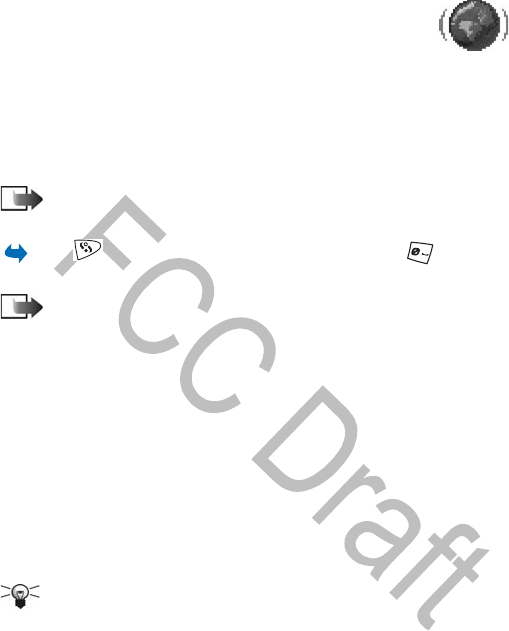
106 Copyright © Nokia 2003
15 Services (XHTML)
Various service providers on the Internet maintain pages specifically
designed for mobile devices, offering services such as news, weather reports,
banking, travel information, entertainment, and games. With the XHTML browser
you can view these services as WAP pages written in WML, XHTML pages written
in XHTML, or a mixture of both.
XHTML browser supports pages written in the Extensible Hypertext Markup
Language (XHTML) and the Wireless Markup Language (WML).
Note: Your game deck must be switched on to use this function. Do not
switch the game deck on when wireless device use is prohibited or when
it may cause interference or danger.
Press and go to Media > Services or press and hold in the
standby mode.
Note: Check the availability of services, pricing, and taxes with your
service provider and/or service provider. Service providers will also give
you instructions on how to use their services.
For making a connection, browsing, and ending the connection to the service, see
“Keys and commands” on page 109.
• SET UP BROWSER SERVICE
Receive settings in a smart message
You may receive service settings in a special text message (also called a smart
message) from the network operator or service provider that offers the service. See
“Receive smart messages” on page 79. For more information, contact your network
operator or service provider, or visit Club Nokia’s Web site
(www.club.NokiaUSA.com).
Tip: Settings may be available, for example, on the Web site of a network
operator or service provider.
Key in settings
Follow the instructions given by your service provider.
1Go to Settings > Connection settings > Access points and define the settings
for an access point.
See “Connection settings” on page 40.
2Go to Services > Options > Add bookmark.
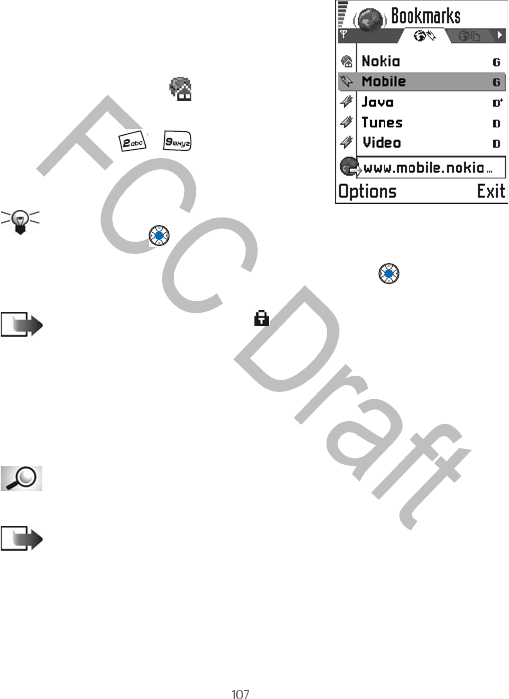
Nokia #### User Guide Copyright © Nokia 2003
Services (XHTML)
3Write a name for the bookmark and the address of the browser page defined
for the current access point.
• MAKE A CONNECTION
Once you have stored all the required connection
settings, you can access browser pages.
There are three different ways to access browser
pages:
• Select the homepage ( ) of your service
provider.
• Select a bookmark from Bookmarks.
• Press the keys — to begin writing the
address of a browser service. The Go to field at
the bottom of the display is activated and you
can continue writing the address there
Tip: To access Bookmarks while browsing,
press and hold . To return to the browser view again, select Options >
Back to page.
After you have selected a page or written the address, press to start to
downloading the page. See also “Data connection indicators” on page 6.
Note: .If the security indicator appears during a connection, this
indicates the data transmission between the device and the browser
gateway (or browser server) is encrypted. It does not, however, indicate
that the data transmission between the gateway and the content server (place
where the requested resource is stored) is necessarily secure.
•VIEW BOOKMARKS
Glossary: A bookmark consists of an Internet address (mandatory),
bookmark title, WAP access point, and if the service requires, a user name
and password.
Note: Your game deck may have some pre-installed bookmarks for sites
not affiliated with Nokia. Nokia does not warrant or endorse these sites.
If you choose to access them, you should take the same precautions, for
security or content, as you would with any site.
Options in Bookmarks (selection on a bookmark or folder) are Open, Download,
Back to page, Send, Go to URL address and Find bookmark, Add bookmark, Edit,
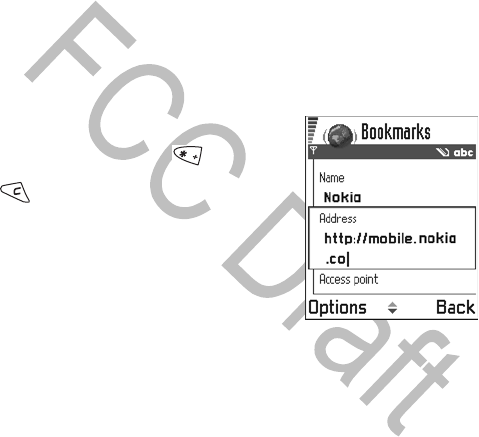
108 Copyright © Nokia 2003
Delete, Read service msgs., Disconnect, Move to folder, New folder, Mark/
Unmark, Rename, Clear cache, Details, Add to Favorites, Settings, Help, and Exit.
In Bookmarks, you can see bookmarks pointing to different kinds of web pages.
Bookmarks are indicated by the following icons:
• The homepage defined for the browser access point. If you use another web
access point for browsing, the homepage is changed accordingly.
• The last visited page. When the game deck is disconnected from the service,
the address of the last visited page is kept in memory until a new page is
visited during the next connection.
• A bookmark showing the title.
When you scroll through bookmarks, you can see the address of the highlighted
bookmark in the Go to field at the bottom of the display.
Add bookmarks manually
1In Bookmarks, select Options > Add bookmark.
2Fill in the fields.
Only the address must be defined. The default
access point is assigned to the bookmark if no
other one is selected. Press to enter
special characters such as /, ., :, and @. Press
to clear characters.
3Select Options > Save to save the bookmark.
Send bookmarks
To send a bookmark, scroll to it and select Options >
Send > Via text message.
•BROWSE
On a browser page, new links appear underlined in blue and previously visited links
in purple. Images that act as links have a blue border around them.
Options when browsing are Open, Service options, Bookmarks, History, Go to
URL address, View image, Read service msgs., Save as bookmark, Send
bookmark, Reload, Disconnect, Show images, Clear cache, Save page, Find,
Details, Session, Security, Settings, Help, and Exit.
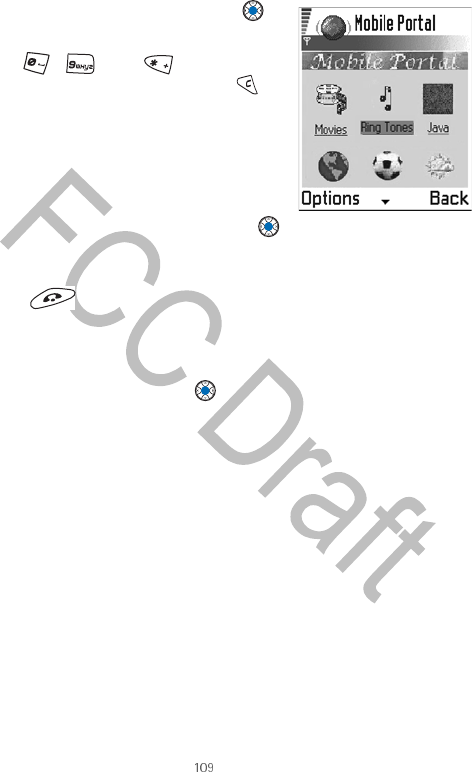
Nokia #### User Guide Copyright © Nokia 2003
Services (XHTML)
Keys and commands
• To open a link, select the link and press .
• To scroll the view, use the controller key.
• To enter letters and numbers in a field, press the
keys —. Press to enter special
characters such as /, ., :, and @. Press to
clear characters.
• To go to the previous page while browsing,
press Back. If Back is not available, select
Options > History to view a chronological list
of the pages you have visited during a browsing
session. The history list is cleared each time a
session is closed.
• To check boxes and make selections, press .
• To retrieve the latest content from the server, select Options > Reload.
• To open a sublist of commands or actions for the currently open web page,
select Options > Service options.
• Press to disconnect from a web service and to quit browsing.
VIEW SERVICE MESSAGES
To download and view new service messages while browsing:
1Select Options > Read service msgs. (shown only if there are new messages).
2Scroll to the message and press to download and open it.
For more information about service messages, see “Service messages” on page 80.
SAVE BOOKMARKS
• To save a bookmark while browsing, select Options > Save as bookmark.
• To save a bookmark received in a smart message, open the message in the
Inbox in Messaging and select Options > Save to bookmarks. See also
“Receive smart messages” on page 79.
View saved pages
If you regularly browse pages containing information which does not change very
often you can save and then browse them when offline. If you have a memory card,
you can save web pages on it instead of the game deck’s memory.
Options in the Saved pages view are Open, Back to page, Reload, Remove, Read
service msgs., Disconnect, Move to folder, New folder, Mark/Unmark, Rename,
Clear cache, Details, Add to Favorites, Settings, Help, and Exit.
• To save a page while browsing, select Options >Save page.
Saved pages are indicated by the following icon:(NEED ICONS/CL)
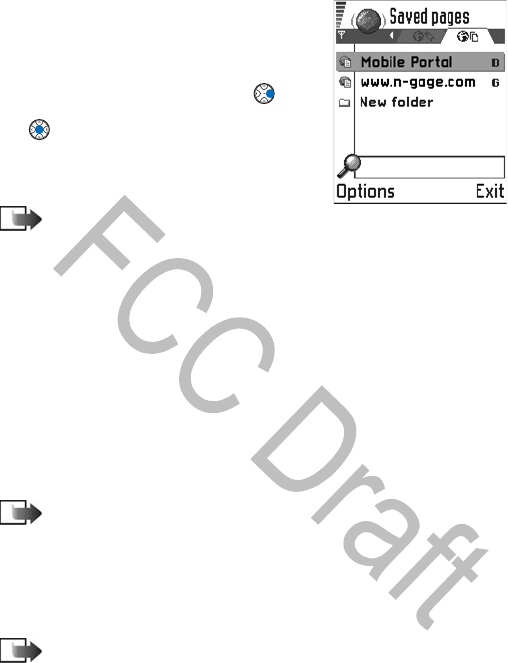
110 Copyright © Nokia 2003
The saved web page.
In the saved pages view, you can create folders
to store your saved web pages.
Folders are indicated by the following icon:
Folder containing saved web pages.
• To open the Saved pages view, press in the
Bookmarks view. In the Saved pages view, press
to open a saved page.
If you want to start a connection to the web service
and to retrieve the page again, select Options >
Reload. You can also arrange the pages into folders.
Note: The game deck stays online after
you reload the page.
•DOWNLOAD
You can download items such as ringing tones, images, operator logos, and video
clips through the mobile browser.
Once downloaded, items are handled by the respective applications on your game
deck, for example, a downloaded image will be saved in the Media > Images.
Download directly from the web page
To download the item directly from a web page, scroll to the link and select
Options > Open.
Purchase an item
Note: Copyright protections may prevent some images, ringtones and
other content from being copied, modified, transferred or forwarded.
To download the item:
• Scroll to the link and select Options > Open.
• Select Buy if you want to buy the item.
Check an item before downloading
Note: Check with your service provide to see if they offer this service.
You can see details about an item before you download it. Details about an item
may include the price, brief description, and size.
• Scroll to the link and select Options > Open.
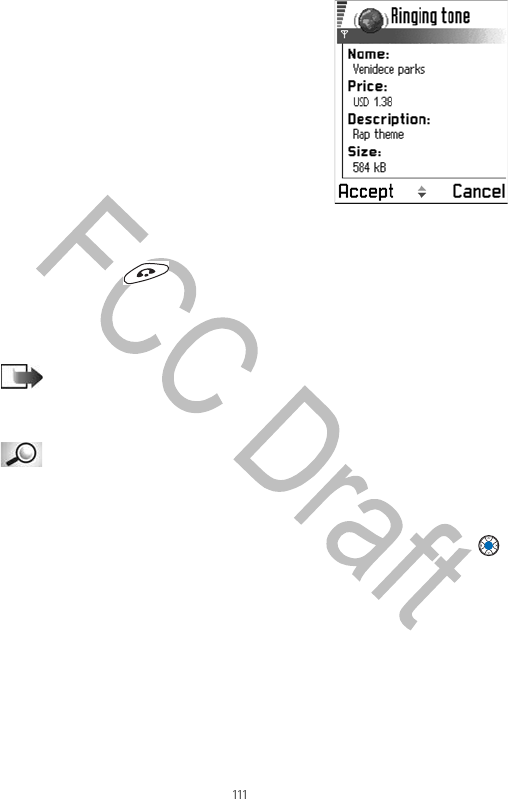
Nokia #### User Guide Copyright © Nokia 2003
Services (XHTML)
Details about the item are displayed on your game
deck.
If you want to continue with the downloading, press
Accept or if you want to cancel the download, press
Cancel.
• END A CONNECTION
•Select Options > Disconnect, or
• Press and hold to quit browsing and to return to the standby mode.
Empty the cache
The information or services you have accessed are stored in the cache memory of
the game deck.
Note: If you have tried to access or have accessed confidential
information requiring passwords (for example, your bank account), empty
the cache of your game deck after each use. To empty the cache, select
Options > Clear cache.
Glossary: A cache is a buffer memory that is used to store data
temporarily.
• BROWSER SETTINGS
Default access point—If you want to change the default access point, press
to open a list of available access points. The current default access point is
highlighted. For more information, see “Connection settings” on page 40.
Show images—Choose if you want to view pictures when you are browsing. If you
choose No, you can later load images during browsing by selecting Options >
Show images.
Font size—You can choose three text sizes in the browser: All small normal, large,
and All large.
Cookies—Allow or Decline. You can enable or disable the receiving and sending of
cookies.

112 Copyright © Nokia 2003
Conf. touch tone sending—Always or First time only. The browser supports
functions you can access while browsing. You can make a voice call while you are
on a web page, send touch tone tones while a voice call is in progress, and save a
name and phone number from a Web page in Contacts. Choose whether you want
to confirm before the game deck sends DTMF tones during a voice call. See also
“Options during a call” on page 17.
Text wrapping—Choose Off if you do not want the text in a paragraph to
automatically wrap, or On if you do.

Nokia #### User Guide Copyright © Nokia 2003
(Java™) Applications
16 (Java™) Applications
Note: Your game deck must be switched on to use this
function. Do not switch the game deck on when wireless device use is
prohibited or when it may cause interference or danger.
Press and go to Extras > Applications.
In Applications you can open or remove installed Java applications. In Install you
can install new Java applications (file extensions .JAD or .JAR).
Note: Your game deck supports J2Micro Edition™Java applications. Do
not download PersonalJava™ applications to your game deck as they
cannot be installed.
When you open Applications, you can see a list of
Java applications that have been installed to your
game deck.
Options in Applications are Open, View details,
Settings, Remove, Go to URL address, Update,
Help, and Exit.
1Scroll to an application and select Options >
View details to view the following:
Status—Installed, Running, or Downloaded
(shown only in Install view)
Version—the application version number
Supplier—the supplier or manufacturer of the application
Size—the size of the application file in kilobytes
Type—a brief description of the application
URL—an address of an information page on the Internet
Data—the size of application data, such as high scores, in kilobytes
2To start a data connection and to view extra information about the
application, scroll to it and select Options > Go to URL address.
3To start a data connection and to check if there is an update available for the
application, scroll to it and select Options > Update.
Applications uses shared memory. See “Shared memory” on page 12.
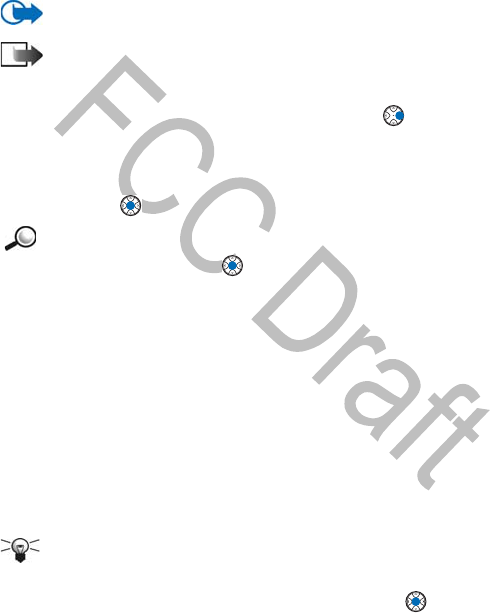
114 Copyright © Nokia 2003
• INSTALL A JAVA APPLICATION
Installation files may be transferred to your game deck from a compatible
computer, downloaded during browsing, or sent to you in a multimedia message as
an e-mail attachment or using a Bluetooth wireless connection. If you are using PC
Suite for Nokia N-Gage game deck to transfer the file, place it in the
c:\nokia\installs folder in your game deck.
Important: Only install software from sources that offer adequate
protection against viruses and other harmful software.
Note: In Install, you can only install Java software installation files with
the extension .JAD or .JAR.
Options in Install are Install, View details, Delete, Help, and Exit.
1In Applications, to view the installation packages, press to open the
Downloaded view.
2To install an application, scroll to an installation file and select Options >
Install.
Alternatively, search the game deck memory for the installation file, select the
file, and press to start the installation.
Tip: If you have received the installation file as an e-mail attachment, go
to your mailbox, open the e-mail, open Attachments, scroll to the
installation file, and press to start the installation.
3Press Yes to confirm the installation.
The .JAR file is required for installation. If it is missing, the game deck may ask
you to download it. If there is no access point defined for applications, you will
be asked to select one. When you are downloading the JAR file, you may need
to enter a user name and password to access the server. You obtain these from
the supplier or manufacturer of the application.
During installation, the game deck checks the integrity of the package to be
installed. The game deck shows information about the checks being carried
out, and you are given options to continue or cancel the installation. Once the
game deck has checked the integrity of the software package, the application
is installed on your game deck.
4The game deck informs you when installation is complete.
To open the Java application after installation, you must go to Applications.
Tip: When you are browsing, you can download an installation file and
install it immediately. Note, however, that the connection is left running
in the background during installation.
To open a Java application, scroll to the application in and press .

Nokia #### User Guide Copyright © Nokia 2003
(Java™) Applications
To uninstall a java application, select the application and select Options > Remove.
• APPLICATION SETTINGS
To define a default access point for downloading missing application components,
select Options > Settings > Default access point. For more information on
creating access points, see the “Access points” on page 42.
Select an application and select Options > Settings, and then select:
•Access point—Select an access point to be used by the application for
downloading extra data.
•Network connection—Some Java applications may require a data connection
to be made to a defined access point. If no access point has been selected, you
will be asked to select one. The options are:
Allowed—The connection is created without a notification.
Ask first—You will be asked before the application makes the connection.
Not allowed—Connections are not allowed.

116 Copyright © Nokia 2003
17 Manager—applications
and software
Note: Your game deck must be switched on to use the
functions in the Tools folder. Do not switch the game deck on when
wireless device use is prohibited or when it may cause interference or
danger.
Press and go to Tools > Manager.
In Manager you can install new applications and software packages, and remove
applications from your game deck. You can also check the memory consumption.
Options in Manager are View details, View certificate, Install, Remove, View log,
Send log, Memory details, Help, and Exit.
When you open Manager, you can see a list of the following:
• Installation packages that have been saved to Manager,
• Partially installed applications (indicated by ), and
• Fully installed applications that you can remove (indicated by ).
Note: In Manager, you can only use device software installation files with
an .SIS extension.
• Scroll to an installation file and select Options > View details to view the
Name, Version, Type, Size, Supplier, and Status of the software package.
• Scroll to a software package and select Options > View certificate to display
the security certificate details of a software package. See “Certificate
management” on page 48.
Important: Only install software from sources that offer adequate
protection against viruses and other harmful software.
Do not install the application if Manager gives a security warning during
installation.
Tip: To install Java applications (file extension .JAD or .JAR), go to
Applications. For further information, see “(Java™) Applications” on
page 113 .
•INSTALL SOFTWARE
You can install applications that are specifically intended for the Nokia N-Gage
game deck or suitable for the Symbian operating system. A software package is
usually one large compressed file containing many component files.
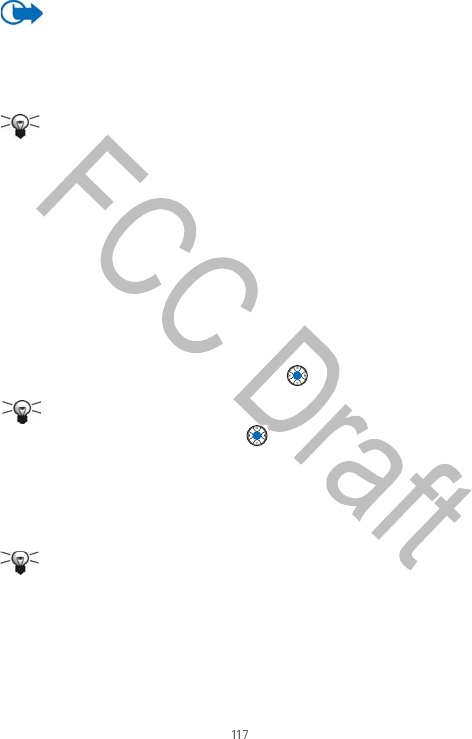
Nokia #### User Guide Copyright © Nokia 2003
Manager—applications and software
If you install a program that is not intended specifically for the Nokia N-Gage game
deck, it may function and look very different from the usual Nokia N-Gage game
deck applications.
Important: If you install a file that contains an update or repair to an
existing application, you can only restore the original application if you
have the original installation file or a full back-up copy of the removed
software package. To restore the original application, first remove the
application and then install the application again from the original
installation file or the back-up copy.
Tip: Select Options > View log to see what software packages have been
installed or removed and when.
• Installation packages may be transferred to your game deck from a compatible
computer, downloaded during browsing, or sent to you in a multimedia
message as an e-mail attachment, or using a Bluetooth connection. If you are
using PC Suite for Nokia N-Gage game deck to transfer the file, place it in the
c:\nokia\installs folder on your game deck.
• Installation packages may be transferred to your game deck from a compatible
computer using the supplied DKE-2 mini-B USB cable. If you are using
Microsoft Windows Explorer to transfer the file from the CD-ROM to the Nokia
N-Gage game deck, place it on your memory card (local disk).
•Open Manager, scroll to the installation package, and select Options > Install
to start the installation.
Alternatively, search the game deck memory or the memory card for the
installation file, select the file, and press to start the installation.
Tip: If you have received the installation file as an e-mail attachment, go
to your mailbox, open the e-mail, open the Attachments view, scroll to
the installation file, and press to start the installation.
During installation, the game deck checks the integrity of the package to be
installed. The game deck shows information about the checks being carried out and
you are given options whether to continue or cancel the installation. Once the
game deck has checked the integrity of the software package, the application is
installed on your game deck.
Tip: To send your installation log to a help desk so that they can see what
has been installed or removed, select Options > Send log > Via text
message or Via e-mail (available only if the correct e-mail settings are in
place).
• REMOVE SOFTWARE
1To remove a software package, scroll to it and select Options > Remove.

118 Copyright © Nokia 2003
2Press Yes to confirm the removal.
If you remove software, you can only re-install it if you have the original software
package or a full back-up of the removed software package. If you remove a
software package, you may no longer be able to open documents created with that
software. If another software package depends on the software package that you
removed, the other software package may stop working. Refer to the
documentation of the installed software package for details.
• VIEW MEMORY CONSUMPTION
To open the memory view select Options > Memory details.
Note: If you have a memory card installed on your game deck, you will
have a choice of two memory views, one for the game deck or Device
memory and one for the Memory card. If not, you will only have the
Device memory view.
When you open either of the memory views, the game deck calculates the amount
of free memory for storing data and installing new software. In the memory views,
you can view the memory consumption of the different data groups: Calendar,
Contacts, Documents, Messages, Images, Sound files, Video clips, Applications,
Mem. in use, and Free memory.
Tip: If the game deck memory is getting low, remove some documents, or
move them to the memory card. See also the “Troubleshooting” on
page 127.

Nokia #### User Guide Copyright © Nokia 2003
Connectivity
18 Connectivity
Note: Your game deck must be switched on to use the functions in the
Tools folder. Do not switch the game deck on when wireless device use is
prohibited or when it may cause interference or danger.
Press and go to Tools > Bluetooth.
You can transfer data from your game deck to another compatible device, for
example, a phone or a computer, using a Bluetooth wireless connection.
• BLUETOOTH WIRELESS
CONNECTION
Note: The Nokia N-Gage game deck is compliant with and adopts
Bluetooth Specification 1.1. However, interoperability between the game
deck and other products with wireless technology is not guaranteed and
depends on compatibility. For more information on the compatibility with
Bluetooth wireless devices, please review the product user information or
check with the manufacturer.
You can play two player or multiple player games using a Bluetooth wireless
connection with friends who have the same game on a compatible device. See
“Games” on page 26. You can use a Bluetooth connection in Offline profile;
however, in this Offline profile the device does not make or receive wireless phone
calls. See “Offline profile” on page 93.
Tip: You can also play game deck-to-game deck games using Bluetooth
wireless technology.
Bluetooth wireless technology enables cost-free connections between electronic
devices within a maximum range of 30 feet (10 meters). A wireless connection can
be used to play games, send images, videos, texts, business cards, calendar notes,
or to connect wirelessly to compatible devices such as computers.
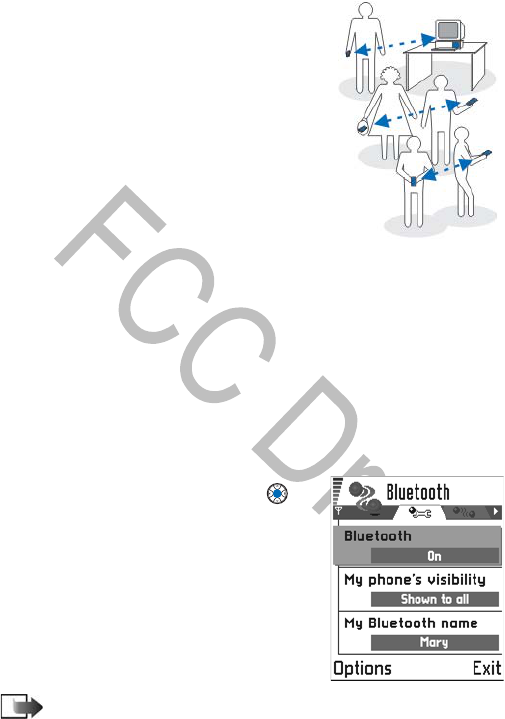
120 Copyright © Nokia 2003
Since Bluetooth wireless devices communicate
using radio waves, your game deck or other
compatible devices do not need to be in direct
line-of-sight.
The two devices only need to be within a maximum
of 30 feet (10 meters) of each other, although the
connection can be subject to interference from
obstructions such as walls or from other electronic
devices.
Using wireless connections consumes the battery
and the game deck operating time will be reduced.
Take this into account when performing other
operations with your game deck.
There may be restrictions on using wireless
technology devices. Check with your local
authorities.
Initial Activation
When you activate the Bluetooth wireless application for the first time, you are
asked to assign a Bluetooth name to your game deck.
Write a name (up to 30 letters) or use the default name, “Nokia N-Gage game
deck”.’. If you send data using a Bluetooth connection before you have assigned an
individual Bluetooth name to your game deck, the default name will be used.
Bluetooth connection settings
To modify Bluetooth connection settings, scroll to
the setting you want to change and press .
•Bluetooth—Select On if you want to use a
Bluetooth wireless connection. If you select
Off, all active connections are ended and
cannot be used for sending or receiving data.
•My device’s visibility—If you select Shown to
all, your game deck can be found by other
Bluetooth-compatible devices during a device
search. If you select Hidden, your game deck
cannot be found by other devices during a
device search.
Note: After setting the connection to
active and changed My device’s visibility to Shown to all, your game
deck and this name can be seen by other Bluetooth-compatible device
users.
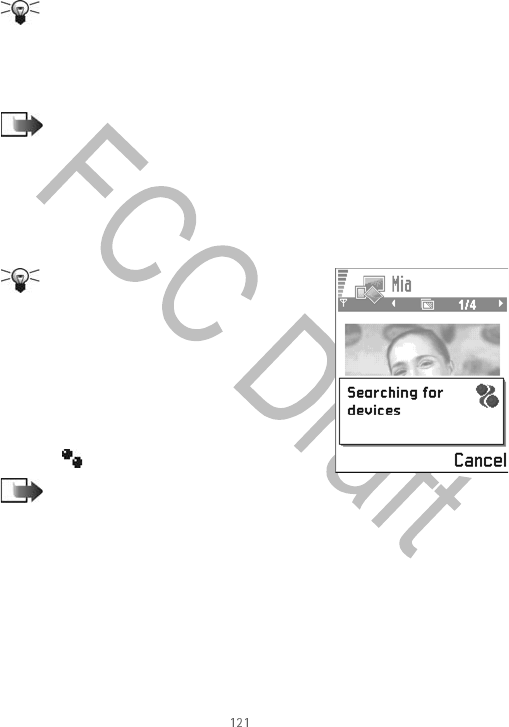
Nokia #### User Guide Copyright © Nokia 2003
Connectivity
•My Bluetooth name—Define a a Bluetooth connection name for your game
deck. After you have set the connection to be active and changed My device’s
visibility to Shown to all this name can be seen by other
Bluetooth-compatible device users.
Tip: When searching for devices, some compatible devices may show only
the unique Bluetooth addresses (device addresses). To find out what the
unique Bluetooth address of your game deck is, enter the code *#2820#
in the standby mode.
Send data
Note: There can be only one active Bluetooth connection at a time.
1Open an application where the item you wish to send is stored. For example,
to send an image to another compatible device, open the Images application,
to send a video clip to another compatible device, open the Video Player
application.
2Scroll to the item you want to send, such as an image, and select Options >
Send > Via Bluetooth.
Tip: To send text using a Bluetooth
connection (instead of text messages), go
to Notes, write the text, and select
Options > Send > via Bluetooth.
The game deck starts to search for devices
within range. Bluetooth-enabled devices that
are within range start to appear on the display
one by one. You can see a device icon, the
device’s Bluetooth name, the device type, or a
short name. Paired devices are shown
with .
Note: If you have searched for
Bluetooth-compatible devices earlier, a list of the devices that were found
previously appears first. To start a new search, select More devices. If you
switch off the game deck, the list of devices is cleared and the device
search needs to be started again before sending data.
1To interrupt the search, press Stop.
The device list freezes and you can start to form a connection to one of the
devices already found.
2Scroll to the desired device and press Select.
The item you are sending is copied to Outbox and Connecting appears.
If the other device requires pairing before data can be transmitted, a tone
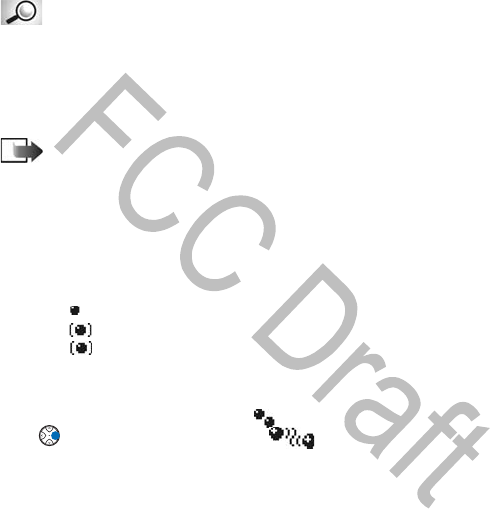
122 Copyright © Nokia 2003
sounds and you are asked to enter a passcode. Complete the following
• Create your own passcode (1-16 characters long, numeric) and agree with
the owner of the other Bluetooth-compatible device to use the same code.
This passcode is used only once and you do not have to memorize it.
• After pairing, the device is saved in Paired devices.
Glossary: Pairing means authentication. The users of the
Bluetooth-enabled devices should agree together what the passcode is
and use the same passcode for both devices in order to pair them. Devices
that do not have a user interface have a factory set passcode.
When the connection has been established, Sending data appears. If sending fails,
the message or data will be deleted. The Drafts folder in Messaging does not store
messages sent using a Bluetooth connection
Note: Data received using a Bluetooth connection can be found in the
Inbox folder in Messaging. See “Inbox—receive messages” on page 77.
ICONS FOR BLUETOOTH-COMPATIBLE DEVICES
•Computer
•Phone
•Other
•Unknown
CHECK BLUETOOTH CONNECTION STATUS
•When appears in the standby mode, a Bluetooth connection is active.
•When is blinking, your game deck is trying to connect to the other device.
•When appears continuously, a Bluetooth connection is active.
Paired devices
Pairing with a device makes device searches easier and quicker. Paired devices are
easier to recognize, they are indicated by in the search result list. In Bluetooth,
press to open a list of paired devices ( ).
Options in Paired devices are New paired device, Connect or Disconnect, Assign
short name, Delete, Delete all, Set as authorized or Set as unauthorized, Help,
and Exit.
PAIR WITH A DEVICE
1Select Options > New paired device in Paired devices.
The game deck searches for devices within range. If you have searched for
Bluetooth-compatible devices earlier, a list of the devices that were already
found appears.
2To start a new search, select More devices.
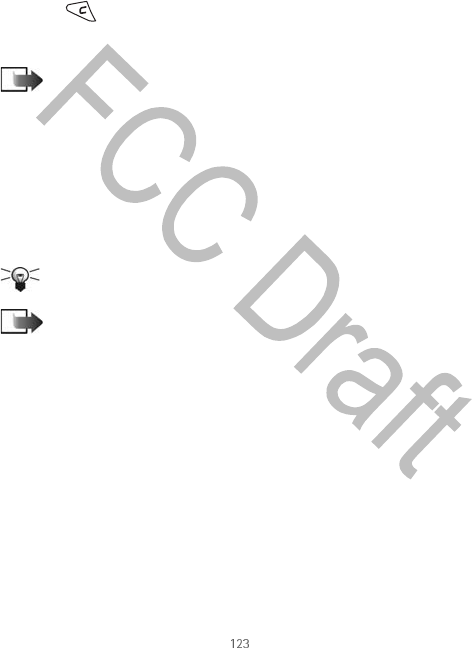
Nokia #### User Guide Copyright © Nokia 2003
Connectivity
3Scroll to the device you want to pair with and press Select.
4Enter your passcode, or create your own passcode (1-16 characters long,
numeric) and agree with the owner of the other Bluetooth-compatible device
to use the same code. This passcode is used only once and you do not have to
memorize it.
After pairing, the device is saved in Paired devices.
CANCEL PAIRING
1In Paired devices, scroll to the device whose pairing you want to cancel and
press or select Options > Delete.
The device is removed from the Paired devices list and the pairing is canceled.
2If you want to cancel all pairings, select Options > Delete all.
Note: If you are currently connected to a device and delete the pairing
with that device, pairing is removed immediately, but the connection will
remain active.
ASSIGN NAMES
You can define a short name (nickname, alias), to help you recognize a certain
device. This name is stored in the game deck memory and cannot be seen by other
Bluetooth-compatible device users.
1To assign a short name, scroll to the device and select Options > Assign short
name.
2Write the short name and press OK.
Tip: Give a short name to your friend’s Bluetooth-enabled device or to
your own computer to be able to recognize it more easily.
Note: Choose a name which is easy to remember and recognize. Later
when you are searching for devices or a device is requesting a connection,
the name you have chosen will be used to identify the device.
SET AUTHORIZATION
After you have paired with a device, you can set it to be authorized or
unauthorized.
Unauthorized (default)—Connection requests from this device need to be accepted
separately every time.
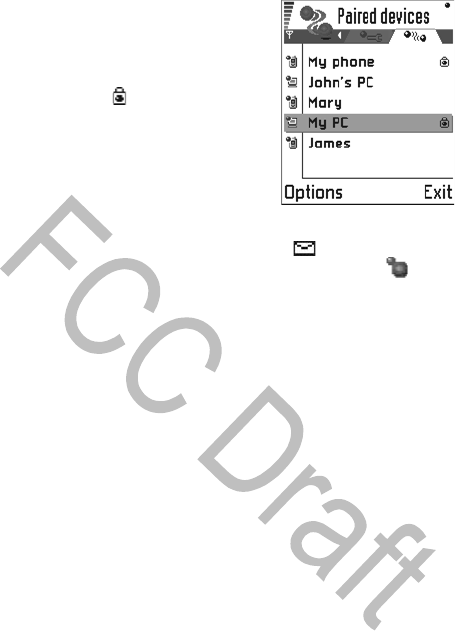
124 Copyright © Nokia 2003
Authorized—Connections between your game deck
and this device can be made without your
knowledge. No separate acceptance or
authorization is needed. Use this status for your own
devices, for example, your PC, or devices that belong
to someone you trust. The icon is added next to
authorized devices in the Paired devices view.
In Paired devices, scroll to the device and select
Options > Set as authorized or Set as
unauthorized.
Receive data
When you receive data using a Bluetooth connection, a tone sounds and you are
asked if you want to accept the message. If you accept, appears and the item
is placed in the Inbox folder in Messaging. Messages are indicated by . See
“Inbox—receive messages” on page 77 for further information.
End a connection
A Bluetooth connection is ended automatically after sending or receiving data.
• CONNECT TO A COMPUTER
For further information on how to make a connection to a compatible computer
using a Bluetooth connection and how to install the PC Suite for Nokia N-Gage
game deck, see the Installation Guide for PC Suite on the CD-ROM in the “Install”
section. For further information on how to use the PC Suite for Nokia N-Gage game
deck, see the PC suite online help.
Use the CD-ROM
The CD-ROM typically starts automatically when inserted into the CD-ROM drive
of your compatible PC. If not, proceed as follows:
1Click the Windows Start button and select Programs > Windows Explorer.
2On the CD-ROM drive, locate a file called Nokia game deck.exe and
double-click it.
The CD-ROM interface opens.
3Locate PC Suite for Nokia N-Gage game deck in the “Install” section.
4Double-click ‘PC Suite for Nokia N-Gage game deck’. The installation wizard
will guide you through the installation process.
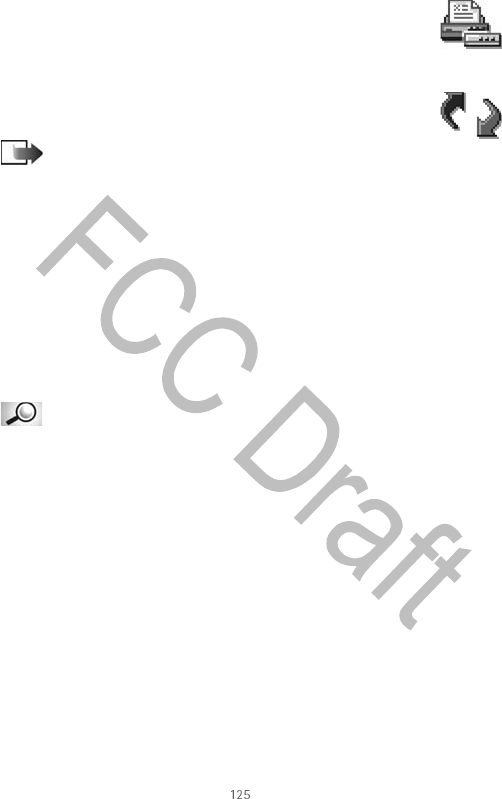
Nokia #### User Guide Copyright © Nokia 2003
Connectivity
Use the modem feature
Detailed installation instructions can be found in Quick Guide for
Nokia Modem Options on the CD-ROM supplied with the game deck.
• SYNC APPLICATION
Note: You have to download the Sync application from the
CD-ROM.
The Sync application enables you to synchronize your calendar or contacts in your
game deck with various calendar and address book applications on a compatible
computer or on the Internet. Synchronization takes place over a GSM data call or
packet data connection.
The synchronization application uses SyncML technology for synchronization. For
information on SyncML compatibility, please contact the supplier of the calendar
or address book application you want to synchronize your game deck data with.
Options in Remote sync are Synchronize, New sync profile, Edit sync profile,
Delete, View log, Help, and Exit.
Create a synch profile
Glossary: Synchronization profile is the settings for the remote server.
You can create several profiles if you need to synchronize your data with
multiple servers or applications.
If no profiles have been defined, the game deck asks you if you want to create
a new profile.
1When that game deck prompts you to create a new profile, select Yes.
To create a new profile in addition to existing ones, select Options > New sync
profile.
2Choose whether you want to use the default setting values or copy the values
from an existing profile to be used as the basis for the new profile.
3Define the following:
Sync profile name—Write a descriptive name for the profile.
Bearer type, Host address, Port, or HTTP authentication—Contact your
service provider or system administrator for the correct values.
Access point—Select an access point you want to use for the data connection.
For more information, see “Connection settings” on page 40.
User name—Your user ID for the synchronization server. Contact your service
provider or system administrator for your correct ID.
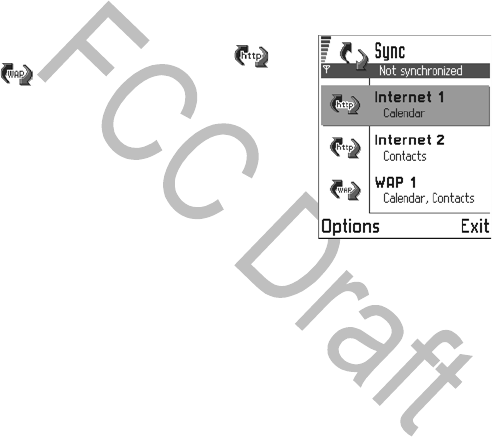
126 Copyright © Nokia 2003
Password—Write your password. Contact your service provider or system
administrator for the correct value.
Calendar—Select Yes if you want to synchronize your calendar.
Remote calendar—Enter a correct path to the remote calendar on the server.
Must be defined if the previous setting Calendar has been set to Yes.
Contacts—Select Yes if you want to synchronize your contacts.
Remote contacts—Enter a correct path to the remote address book on the
server. It must be defined if the previous setting Contacts has been set to Yes.
4Press Done to save the settings.
Synchronize data
In Sync, you can see the different profiles. You can
also see which protocol the profile uses, http
or , WAP and what kind of data will be
synchronized—calendar, contacts, or both.
1In the main view, scroll to a profile and select
Options > Synchronize.
The status of the synchronization appears at
the bottom of the screen.
2To cancel synchronization before it is finished,
press Cancel.
3You are notified when the synchronization has
been completed.
After synchronization is complete, press View log or select Options > View
log to open a log file showing the synchronization status (Complete or
Incomplete) and how many calendar or contact entries have been added,
updated, deleted, or discarded (not synchronized) in the game deck or on the
server.
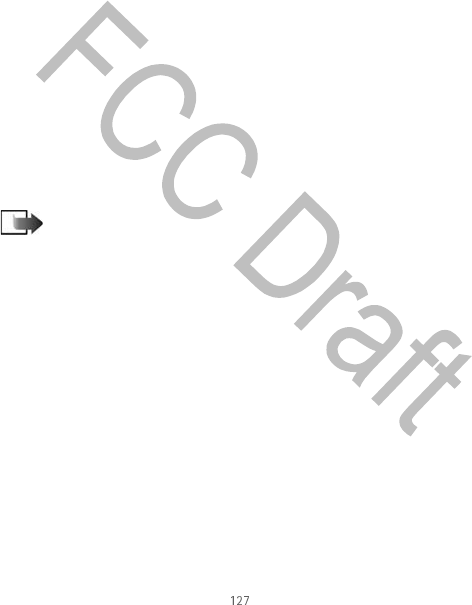
Nokia #### User Guide Copyright © Nokia 2003
Troubleshooting
19 Troubleshooting
If you experience problems with your game deck, Club Nokia Careline (Applicable
to US?) answers questions and offers instructions over the phone. For more
information on the Club Nokia Careline see the Club Nokia invitation in this guide
or go to www.club.NokiaUSA.com.
MEMORY LOW
When the following notes are shown, the game deck memory is low and you must
start to delete some data: Not enough memory to perform operation. Delete some
data first. or Memory low. Delete some data. To view what kind of data you have
and how much memory the different data groups consume, go to Tools > Manager
and select Options > Memory details.
Delete the following items regularly:
• Messages from the Inbox, Drafts, and Sent folders in Messaging
• Retrieved e-mail messages from the game deck memory
• Saved browser pages
•Images in Images
If you want to delete contact information, calendar notes, call timers, call cost
timers, game scores, or any other data, go to the respective application to remove
the data.
Note: If the game deck does not respond, try deleting items one by one.
Clearing calendar memory—To remove more than one event at a time, go to the
Month view and select Options > Delete entry and one of the following:
•Before date—to delete all calendar notes which take place before a certain
date. Enter the date before which all calendar notes will be deleted.
•All entries—to delete all calendar notes
Erasing log information—To erase all the log contents, Recent calls register, and
Messaging delivery reports permanently, go to Logs and select Options > Clear log
or go to Settings > Log duration > No log.
Different ways to store data are as follows:
• Use PC Suite for Nokia N-Gage game deck to copy some information to your
computer.
• Send images to your e-mail address and then save the images to your
computer
• Send data to another Bluetooth-compatible device

128 Copyright © Nokia 2003
Q&A
Game deck display
Q: Why do missing, discolored, or bright dots appear on the screen every time I turn
on my game deck?
A: This is an intrinsic characteristic of the active matrix display. Your game deck
display contains multiple switching elements to control the pixels. A small number
of missing, discolored, or bright dots on the screen might exist.
Bluetooth wireless connections
Q: Why can’t I end a Bluetooth connection?
A: If another device is pairing with your game deck but not sending data, and leaves
the connection open, then the only way to disconnect is to deactivate the
Bluetooth connection link altogether. Go to Bluetooth and select the setting
Bluetooth > Off.
Q: Why can I not find my friend’s Bluetooth-enabled device?
A: Verify that both devices are activated.
Verify that the distance between the two devices is not over 30 feet (10 meters) or
that there are no walls or other obstructions between the devices.
Verify that the other device is not in “hidden” mode.
Multimedia messaging
Q: What should I do when the game deck tells me that it cannot receive a
multimedia message because memory is full?
A: The amount of memory needed is indicated in the error message: Not enough
memory to retrieve message. Delete some data first. To view what kind of data
you have and how much memory the different data groups consume, go to Tools >
Manager and select Options > Memory details. After you have freed up memory,
the multimedia message center tries to send the multimedia messages again
automatically.
Q: What should I do when the game deck displays: Unable to retrieve multimedia
message. Network connection already in use. ?
A: End all active data connections. Multimedia messages cannot be received if
another data connection using a different gateway address is active for browser or
e-mail.
Q: How can I end the data connection when the game deck starts a data
connection again and again? Retrieving message or Trying to retrieve message
again are shown briefly. What is happening?

Nokia #### User Guide Copyright © Nokia 2003
Troubleshooting
A: The game deck is trying to retrieve a multimedia message from the multimedia
messaging center.
Verify that the settings for multimedia messaging have been defined correctly and
that there are no mistakes in phone numbers or addresses. Go to Messaging and
select Options > Settings > Multimedia message.
To stop the game deck from making a data connection, you have the following
options. Go to Messaging and select Options > Settings > Multimedia message.
•Select On receiving msg. > Defer retrieval if you want the multimedia
messaging center to save the message to be retrieved later, for example, after you
have checked the settings. After this change, the game deck still needs to send
information notes to the network. To retrieve the message later, select Retr.
immediately.
•Select On receiving msg. > Decline message if you want to decline all incoming
multimedia messages. After this change, the game deck needs to send
information notes to the network and the multimedia messaging center will
delete all multimedia messages that are waiting to be sent to you.
•Select Multimedia reception > Off if you want to ignore all incoming
multimedia messages. After this change the game deck will not make any
network connections related to multimedia messaging.
Images
Q: Is the format of the image I’m trying to open supported?
A: See “Image details view” on page 60 for further information on the supported
image formats.
Music
Q: Why can’t I transfer music tracks to the game deck?
A: Make sure there is enough space on the memory card. If necessary deleted some
music tracks from the memory card.
Games
Q: Why can I not play the selected game?
A: Check that the correct memory card for the selected game is installed.
Messaging
Q: Why can’t I select a contact?
A: If you cannot select a contact in the Contacts directory, the contact card does
not have a phone number or an e-mail address. Add the missing information to the
contact card in the Contacts application.
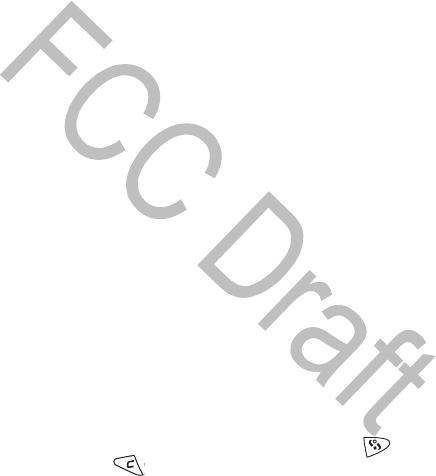
130 Copyright © Nokia 2003
Calendar
Q: Why are the week numbers missing?
A: If you have changed the Calendar settings so that the week will start on some
other day than Monday, then the week numbers will not be shown.
Browser
Q: What should I do when I see the message No valid access point defined. Define
one in Services settings. ?
A: Insert proper browser settings. Contact your browser service provider for
instructions. See “Set up browser service” on page 106.
Log
Q: Why does the log appear empty?
A: You may have activated a filter and no communication events fitting that filter
have been logged. To see all events, select Options > Filter > All communication.
PC connectivity
Q: Why do I have problems in connecting the game deck to my compatible PC?
A: Make sure that PC Suite for Nokia N-Gage game deck is installed and running
on your PC. See the Installation guide for PC Suite on the CD-ROM in the ‘Install’
section. For further information on how to use the PC Suite for Nokia N-Gage game
deck, see the PC suite online help.
Access codes
Q: What is my password for the lock, PIN, or PUK codes?
A: The default lock code is 12345. If you forget or lose the lock code contact your
game deck dealer. If you forget or lose a PIN or PUK code, or if you have not
received such a code, contact your network service provider.
For information about passwords, contact your access point provider, for example,
a commercial Internet service provider (ISP), browser service provider, or network
operator.
Application not responding
Q: How do I close an application that is not responding?
A: Open the application switching window by pressing and holding . Scroll to
the application, and press to close the application.
Too many applications open
Q: Why is the game I am playing running so slowly?

Nokia #### User Guide Copyright © Nokia 2003
Troubleshooting
A: You may have too many applications open. Close applications that you are not
using by pressing and holding . Then scroll to the application, and press
to close the application.

132 Copyright © Nokia 2003
20 Reference information
• BATTERY STATEMENTS
Charging and Discharging
Your phone is powered by a rechargeable battery.
Note that a new battery’s full performance may be achieved only after
two or three complete charge and discharge cycles!
The battery can be charged and discharged hundreds of times but it will
eventually wear out. When the operating time (talk time and standby
time) is noticeably shorter than normal, it is time to buy a new battery.
Use only batteries approved by the phone manufacturer and recharge
your battery only with the chargers approved by the manufacturer.
Unplug the charger when not in use. Do not leave the battery connected
to a charger for longer than a week, since overcharging may shorten its
lifetime. If left unused, a fully charged battery will discharge itself over
time.
Temperature extremes can affect the ability of your battery to charge;
allow it to cool down or warm up first.
*This paragraph should be used ONLY for phones using Ni-Cd AND/OR NiMH
batteries: choose the appropriate battery type*
For good operation times with Ni-Cd/NiMh batteries, discharge the
battery from time to time by leaving your phone switched on until it turns
itself off (or by using the battery discharge facility of any approved
enhancement available for your phone). Do not attempt to discharge the
battery by any other means.
Use the battery only for its intended purpose.
Never use any charger or battery which is damaged or worn out.

Nokia #### User Guide Copyright © Nokia 2003
Reference information
Do not short-circuit the battery. Accidental short-circuiting can occur
when a metallic object (coin, clip, or pen) causes direct connection of the
+ and—terminals of the battery (metal strips on the battery), for example,
when you carry a spare battery in your pocket or purse. Short-circuiting
the terminals may damage the battery or the connecting object.
Leaving the battery in hot or cold places, such as in a closed car in summer
or winter conditions, will reduce the capacity and lifetime of the battery.
Always try to keep the battery between 59°F and 77°F (15°C and 25°C). A
phone with a hot or cold battery may temporarily not work, even when
the battery is fully charged. Batteries' performance is particularly limited
in temperatures well below freezing.
Do not dispose of batteries in a fire!
Dispose of batteries according to applicable local regulations (for
example, recycling). Do not dispose of as household waste.
• USE PROPER CARE AND MAINTENANCE
Your phone is a product of superior design and craftsmanship and should
be treated with care. The suggestions below will help you to fulfill any
warranty obligations and to enjoy this product for many years:
• Keep the phone and all its parts and accessories out of the reach of
small children.
• Keep the phone dry. Precipitation, humidity and all types of liquids or
moisture can contain minerals that will corrode electronic circuits.
• Do not use or store the phone in dusty, dirty areas. Its moving parts
can be damaged.
• Do not store the phone in hot areas. High temperatures can shorten
the life of electronic devices, damage batteries, and warp or melt
certain plastics.
• Do not store the phone in cold areas. When it warms up (to its normal
temperature), moisture can form inside which may damage electronic
circuit boards.

134 Copyright © Nokia 2003
• Do not attempt to open the phone. Nonexpert handling may damage
it.
• Do not drop, knock, or shake the phone. Rough handling can break
internal circuit boards.
• Do not use harsh chemicals, cleaning solvents, or strong detergents
to clean the phone.
• Do not paint the phone. Paint can clog the moving parts and prevent
proper operation.
• Use only the supplied or an approved replacement antenna.
Unauthorized antennas, modifications, or attachments could damage
the phone and may violate regulations governing radio devices.
All of the above suggestions apply equally to your phone, battery, charger
or any enhancement. If any of them are not working properly, take them
to your nearest qualified service facility. The personnel there will assist
you, and if necessary, arrange for service.
• UNDERSTAND IMPORTANT SAFETY INFORMATION
Traffic Safety
Do not use a handheld telephone while driving a vehicle. Always secure
the phone in its holder; do not place the phone on the passenger seat or
where it can break loose in a collision or sudden stop.
Remember road safety always comes first!
Operating environment
Remember to follow any special regulations in force in any area and
always switch off your phone whenever it is forbidden to use it, or when
it may cause interference or danger.
Use the phone only in its normal operating positions.
*Magnetic precautions—only in phones with magnetic
interference issues*

Nokia #### User Guide Copyright © Nokia 2003
Reference information
Parts of the phone are magnetic. Metallic materials may be attracted to
the phone, and persons with a hearing aid should not hold the phone to
the ear with the hearing aid. Always secure the phone in its holder,
because metallic materials may be attracted by the earpiece. Do not place
credit cards or other magnetic storage media near the phone, because
information stored on them may be erased.
Electronic devices
Most modern electronic equipment is shielded from radio frequency (RF)
signals. However, certain electronic equipment may not be shielded
against the RF signals from your wireless phone.
PACEMAKERS
Pacemaker manufacturers recommend that a minimum separation of
6 inches (20 cm) be maintained between a handheld wireless phone and
a pacemaker to avoid potential interference with the pacemaker. These
recommendations are consistent with the independent research by and
recommendations of Wireless Technology Research. Persons with
pacemakers:
• Should always keep the phone more than 6 inches (20 cm) from their
pacemaker when the phone is switched on
• Should not carry the phone in a breast pocket
• Should use the ear opposite the pacemaker to minimize the potential
for interference.
• If you have any reason to suspect that interference is taking place,
switch off your phone immediately.
HEARING AIDS
Some digital wireless phones may interfere with some hearing aids. In the
event of such interference, you may want to consult your service provider.
Other medical devices
Operation of any radio transmitting equipment, including cellular phones,
may interfere with the functionality of inadequately protected medical
devices. Consult a physician or the manufacturer of the medical device to

136 Copyright © Nokia 2003
determine if they are adequately shielded from external RF energy or if
you have any questions. Switch off your phone in health care facilities
when any regulations posted in these areas instruct you to do so.
Hospitals or health care facilities may be using equipment that could be
sensitive to external RF energy.
Vehicles
RF signals may affect improperly installed or inadequately shielded
electronic systems in motor vehicles (for example, electronic fuel
injection systems, electronic antiskid/antilock braking systems, electronic
speed control systems, air bag systems). Check with the manufacturer or
its representative regarding your vehicle. You should also consult the
manufacturer of any equipment that has been added to your vehicle.
Posted facilities
Switch your phone off in any facility where posted notices so require.
Potentially explosive atmospheres
Switch off your phone when in any area with a potentially explosive
atmosphere and obey all signs and instructions. Sparks in such areas could
cause an explosion or fire resulting in bodily injury or even death.
Users are advised to switch off the phone when at a refueling point
(service station). Users are reminded of the need to observe restrictions on
the use of radio equipment in fuel depots (fuel storage and distribution
areas), chemical plants, or where blasting operations are in progress.
Areas with a potentially explosive atmosphere are often but not always
clearly marked. They include below deck on boats; chemical transfer or
storage facilities; vehicles using liquefied petroleum gas (such as propane
or butane); areas where the air contains chemicals or particles, such as
grain, dust, or metal powders; and any other area where you would
normally be advised to turn off your vehicle engine.

Nokia #### User Guide Copyright © Nokia 2003
Reference information
Vehicles
Only qualified personnel should service the phone or install the phone in
a vehicle. Faulty installation or service may be dangerous and may
invalidate any warranty which may apply to the unit.
Check regularly that all wireless phone equipment in your vehicle is
mounted and operating properly.
Do not store or carry flammable liquids, gases, or explosive materials in
the same compartment as the phone, its parts, or accessories.
For vehicles equipped with an air bag, remember that an air bag inflates
with great force. Do not place objects, including both installed or portable
wireless equipment in the area over the air bag or in the air bag
deployment area. If in-vehicle wireless equipment is improperly installed
and the air bag inflates, serious injury could result.
*Aircraft statement for non US handportables and transportables*
Using your phone while in the air is prohibited. Switch off your phone
before boarding an aircraft. The use of wireless telephones in an aircraft
may be dangerous to the operation of the aircraft, disrupt the wireless
telephone network, and may be illegal.
*Aircraft statement for US handportables and transportables*
FCC regulations prohibit using your phone while in the air. Switch off your
phone before boarding an aircraft. The use of wireless telephones in an
aircraft may be dangerous to the operation of the aircraft, disrupt the
wireless telephone network, and may be illegal.
Failure to observe these instructions may lead to suspension or denial of
telephone services to the offender, legal action, or both.
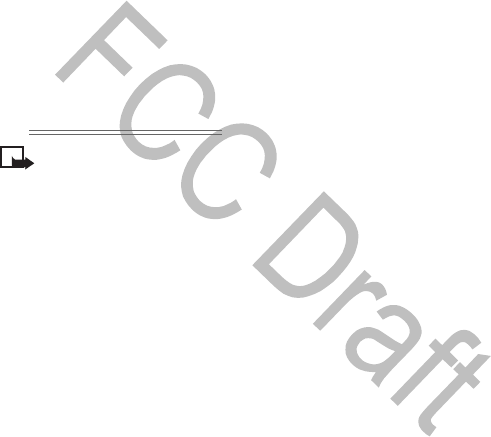
138 Copyright © Nokia 2003
• EMERGENCY CALLS
Important: This phone, like any wireless phone, operates using radio
signals, wireless, and landline networks as well as user-programed
functions. Because of this, connections in all conditions cannot be
guaranteed. Therefore you should never rely solely upon any wireless
phone for essential communications (for example, medical
emergencies).
Emergency calls may not be possible on all wireless phone networks or
when certain network services and/or phone features are in use. Check
with local service providers.
To make an emergency call:
1If the phone is not on, switch it on. Check for adequate signal
strength.
PHONES WITH SIM CARDs
Some networks may require that a valid SIM card is properly
inserted in the phone.
2Press [handset down] as many times as needed (for example, to exit
a call, to exit a menu, etc.) to clear the display and ready the phone
for calls.
3Key in the emergency number for your present location (for example,
911 or other official emergency number). Emergency numbers vary by
location.
4Press the [handset up] /[send] key.
If certain features are in use, you may first need to turn those features off
before you can make an emergency call. Consult this user guide and your
local cellular service provider.
When making an emergency call, remember to give all the necessary
information as accurately as possible. Remember that your wireless phone
may be the only means of communication at the scene of an accident—do
not end the call until given permission to do so.

Nokia #### User Guide Copyright © Nokia 2003
Reference information
PHONES WITH EOTD/E911
The following text wil be required when the phone supports the
emergency automatic location information.
This phone supports FCC mandated emergency location service. This
feature may not be supported by emergency response numbers or wireless
phone networks in all areas. Emergency calls may not be possible on all
wireless phone networks or when certain network services and/or phone
features are in use. Check with local service providers.

140 Copyright © Nokia 2003
• CERTIFICATION INFORMATION (SAR)
THIS MODEL PHONE MEETS THE GOVERNMENT’S REQUIREMENTS FOR
EXPOSURE TO RADIO WAVES.
Your wireless phone is a radio transmitter and receiver. It is designed and
manufactured not to exceed the emission limits for exposure to radio
frequency (RF) energy set by the Federal Communications Commission of
the U.S. Government. These limits are part of comprehensive guidelines
and establish permitted levels of RF energy for the general population. The
guidelines are based on standards that were developed by independent
scientific organizations through periodic and thorough evaluation of
scientific studies. The standards include a substantial safety margin
designed to assure the safety of all persons, regardless of age and health.
The exposure standard for wireless mobile phones employs a unit of
measurement known as the Specific Absorption Rate, or SAR. The SAR
limit set by the FCC is 1.6W/kg.* Tests for SAR are conducted using
standard operating positions accepted by the FCC with the phone
transmitting at its highest certified power level in all tested frequency
bands. Although the SAR is determined at the highest certified power
level, the actual SAR level of the phone while operating can be well below
the maximum value. This is because the phone is designed to operate at
multiple power levels so as to use only the power required to reach the
network. In general, the closer you are to a wireless base station antenna,
the lower the power output.
Before a phone model is available for sale to the public, it must be tested
and certified to the FCC that it does not exceed the limit established by
the government-adopted requirement for safe exposure. The tests are
performed in positions and locations (for example, at the ear and worn on
the body) as required by the FCC for each model. The highest SAR value
for this model phone as reported to the FCC when tested for use at the
ear is .24 W/kg, and when worn on the body, as described in this user
guide, is .47 W/kg. (Body-worn measurements differ among phone
models, depending upon available accessories and FCC requirements).

Nokia #### User Guide Copyright © Nokia 2003
Reference information
While there may be differences between the SAR levels of various phones
and at various positions, they all meet the government requirement.
The FCC has granted an Equipment Authorization for this model phone
with all reported SAR levels evaluated as in compliance with the FCC RF
exposure guidelines. SAR information on this model phone is on file with
the FCC and can be found under the Display Grant section of
http://www.fcc.gov/oet/fccid after searching on FCC ID PDN-NEM-4.
For body-worn operation, this phone has been tested and meets the FCC
RF exposure guidelines for use with an enhancement that contains no
metal and that positions the handset a minimum of 5/8 inch (1.5 cm) from
the body. Use of other accessories may not ensure compliance with FCC
RF exposure guidelines.
If you do not use a body-worn enhancement and are not holding the
phone at the ear, position the handset a minimum of 5/8 inch (1.5 cm)
from your body when the phone is switched on.
*In the United States and Canada, the SAR limit for mobile phones used
by the public is 1.6 watts/kilogram (W/kg) averaged over one gram of
tissue. The standard incorporates1Use enhancements safely
A few practical rules for enhancement operation:
• Keep all accessories out of the reach of small children.
• When you disconnect the power cord of any enhancement, grasp and
pull the plug, not the cord.
• Check regularly that any vehicle-installed accessories are mounted
and are operating properly.
• Installation of any complex car accessories must be made by qualified
personnel only.
• Use only batteries, chargers, and accessories that have been approved
by the phone manufacturer. The use of any other types could
invalidate any approval or warranty applying to the phone and could
be dangerous.
1

142 Copyright © Nokia 2003
•ENHANCEMENTS
Add enhancement information for your phone here.
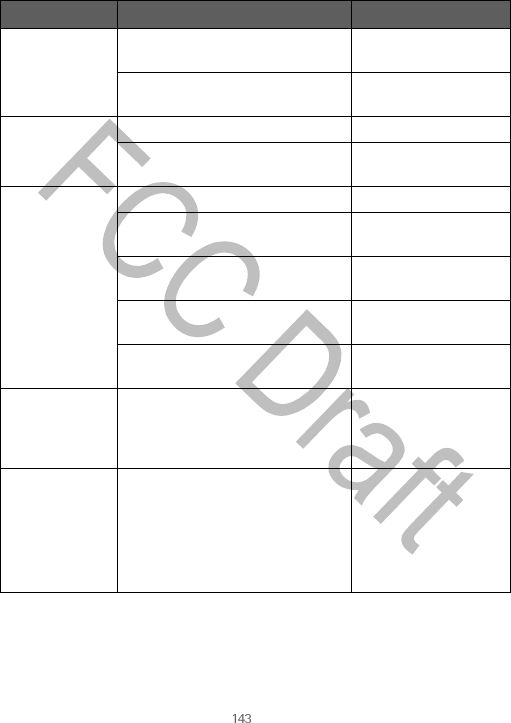
Nokia #### User Guide Copyright © Nokia 2003
Troubleshooting
21 Troubleshooting
The following table lists some common problems and their solutions.
Problem Possible cause Possible solution
My phone isn’t
charging
The charger and phone aren’t properly
connected
Securely connect the
charger to the phone
The charger is not properly plugged into
the wall
Ensure the charger is
plugged in correctly
My phone isn’t
making/receiving
calls
The battery isn’t charged Charge the battery
The signal strength is poor If you are indoors, move
toward a window
I can’t listen to my
voice messages
You don’t have voicemail service Call your wireless provider
You haven’t setup your voicemail service
with your wireless provider
Call your wireless provider
You haven’t saved your voicemail
number to your phone
See “Call your voice
mailbox” on page 14.
You’ve forgotten your password or are
entering it incorrectly
Call your wireless provider
The voicemail number you have saved to
your phone is incorrect
Call your wireless provider
When I insert my
SIM card into
another phone, it’s
rejected
Fixed dialing is activated on your SIM
card and the receiving phone doesn’t
support fixed dialing
Deactivate fixed dialing on
the SIM
I can’t hear the
radio.
A proper enhancement (headset or music
stand) is not connected to the phone.
No radio frequencies are saved in
memory.
Volume needs adjustment.
Connect the proper
enhancement.
See “Radio” on page 30.
See “Volume control” on
page 9 to locate the
volume key.
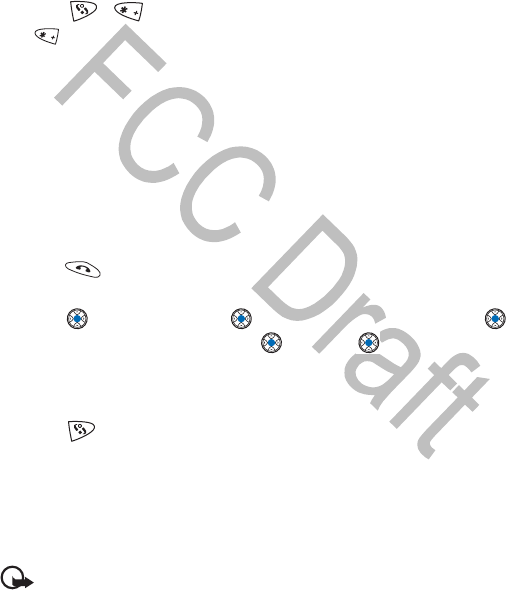
144 Copyright © Nokia 2003
22 Frequently asked questions
This section lists answers to the most frequently asked questions.
Q. What is my security code?
A. The default security code is 12345. However, Nokia recommends that you
change this code immediately. Certain features can be used only after the
correct security code has been successfully entered.
Q. How do I lock and unlock the keypad?
A. Press to lock the keypad. To unlock the keypad, press Unlock
.
Q. How do I make the phone ring louder?
A. See “Profiles” on page 92 for more details.
Q. How do I change the ringing tone?
A. See “Profiles” on page 92 for more details.
Q. How do I store my voice mailbox number?
A. See “Change the voice mailbox number” on page 15.
Q. How do I call my voice mailbox number (retrieve voice messages)?
A. See “Call your voice mailbox” on page 14.
Q. How do I redial the last-dialed number?
A. Press twice.
Q. How do I assign a key to 1-touch dialing?
A. Press , scroll to Tools, press , scroll to 1-touch dialing, and press .
Scroll to the first (empty) slot, press and press twice.
Enter or retrieve the name/number you want to assign to the key and press
Select. Repeat these steps as many times as necessary.
Q. How do I check the memory status?
A. Press > Tools > Memory card
Q. How do I find my phone’s Model number and IMEI number?
A. The model number and IMEI numbers are located on a label under the phone’s
battery. Turn your phone off, remove the back cover and then remove the
battery from the phone.
Q. How do I clear my call timers?
Important: Clearing call timers cannot be undone.

Nokia #### User Guide Copyright © Nokia 2003
Frequently asked questions
A. Press > Extras > Log > Call duration >All calls.
Press Options then select Clear timers.
When the Lock code prompt appears, enter your security code
and press OK.

146 Copyright © Nokia 2003
23 Glossary (to be updated)
Business card A business card is the same as an entry in the Contacts list. It may
contain a name, phone number, and text entry. It can also be sent to
other devices.
Call forwarding A network services feature you use to forward incoming calls to
another number.
Call lists A list used to track numbers for incoming, outgoing, or missed calls.
Call log A log that registers information about calls you make
and receive.
Call timers Timers used to track the amount of time you spend on calls.
Call waiting A network services feature that enables your phone to beep while
you are in the middle of a call. The beep lets you know that someone
else is calling you.
Electronic serial
number (ESN)
The identification number that is assigned to the phone. This number
is located under the battery.
In-call options Features available for use while you are in a call.
Keyguard Locks the keypad to prevent accidental key presses.
Keypad tones The tone you hear when you press a key.
Menu A list of choices you can make to change settings on your phone or
use various phone features.
MMS Acronym for “Multimedia messaging service.”
Predictive text A method of entering information in your phone that uses a
dictionary to predict, or guess, what you are writing.
Profile A group of settings you can use to customize the way your phone
works.
Quick save A fast method for saving a number.

Nokia #### User Guide Copyright © Nokia 2003
Glossary (to be updated)
Ringing tone The sound your phone makes when you receive a call. Ringing tones
can be ringing sounds or short tunes.
Scroll bar A bar that appears on the right side of the screen when you scroll
through the main menus.
SMS Acronym for “short message service.”
Start screen Your phone’s idle screen.
Voice mail A network services feature that enables people who call and miss
you to leave a voice message on your phone.
Warning tones Sounds your phone makes during error conditions, during
confirmations, when the battery is low, and when you need to
recharge the battery.

148 Copyright © Nokia 2003
24 Technical information (to be updated)
Feature Specification
Weight 4.8 oz (137 g) with BL-5C 850 mAh Li-Ion Battery
Size 5.26 x 2.74 x .79 in (length, width, thickness)
Frequency range Lowband
824–849 MHz (TX)
869–894 MHz (RX)
Highband
1850–1910 MHz (TX)
1930–1990 MHz (RX)
Tx output power Lowband: Up to 2 W
Highband: Up to 1 W
Battery voltage 3.6 V nominal
Operating
temperature
14°F to +131°F (-10°C to +55°C)
aTalk time, standby
time
a. Battery talk and standby times are estimates only and depend on signal strength,
network conditions, features used, battery age and condition (including the effect
of charging habits), temperatures to which battery is exposed, use in digital mode,
and many other factors. Please note that the amount of time a phone is used for
calls will affect its standby time. Likewise, the amount of time that the phone is
turned on and in the standby mode will affect its talk–time.
Talk–time: up to 2 hours
Talk–time with speaker: up to 4 hours
Stand by time: up to 10 days
Music player: up to 8 hours
Radio on with headset: up to 20 hours
Radio on with speaker(??): up to 16 hours
Games: 3–6 hours

Nokia #### User Guide Copyright © Nokia 2003
Technical information (to be updated)
• Nokia ONE-YEAR LIMITED WARRANTY
Nokia Inc. (“Nokia”) warrants that this cellular phone (“Product”) is free
from defects in material and workmanship that result in Product failure
during normal usage, according to the following terms and conditions:
1The limited warranty for the Product extends for ONE (1) year beginning
on the date of the purchase of the Product. This one year period is
extended by each whole day that the Product is out of your possession
for repair under this warranty.
2The limited warranty extends only to the original purchaser (“Consumer”)
of the Product and is not assignable or transferable to any subsequent
purchaser/end-user.
3The limited warranty extends only to Consumers who purchase the
Product in the United States of America.
4During the limited warranty period, Nokia will repair, or replace, at
Nokia’s sole option, any defective parts, or any parts that will not
properly operate for their intended use with new or refurbished
replacement items if such repair or replacement is needed because
of product malfunction or failure during normal usage. No charge
will be made to the Consumer for any such parts. Nokia will also
pay for the labor charges incurred by Nokia in repairing or replacing
the defective parts. The limited warranty does not cover defects in
appearance, cosmetic, decorative or structural items, including
framing, and any non-operative parts. Nokia’s limit of liability under
the limited warranty shall be the actual cash value of the Product at
the time the Consumer returns the Product for repair, determined by
the price paid by the Consumer for the Product less a reasonable
amount for usage. Nokia shall not be liable for any other losses or
damages. These remedies are the Consumer’s exclusive remedies for
breach of warranty.

150 Copyright © Nokia 2003
5Upon request from Nokia, the Consumer must prove the date of the
original purchase of the Product by a dated bill of sale or dated
itemized receipt.
6The Consumer shall bear the cost of shipping the Product to Nokia in
Melbourne, Florida. Nokia shall bear the cost of shipping the Product
back to the Consumer after the completion of service under this
limited warranty.
7The Consumer shall have no coverage or benefits under this limited
warranty if any of the following conditions are applicable:
a) The Product has been subjected to abnormal use, abnormal
conditions, improper storage, exposure to moisture or dampness,
unauthorized modifications, unauthorized connections,
unauthorized repair, misuse, neglect, abuse, accident, alteration,
improper installation, or other acts which are not the fault of
Nokia, including damage caused by shipping.
b) The Product has been damaged from external causes such as
collision with an object, or from fire, flooding, sand, dirt,
windstorm, lightning, earthquake or damage from exposure to
weather conditions, an Act of God, or battery leakage, theft,
blown fuse, or improper use of any electrical source, damage
caused by computer or internet viruses, bugs, worms, Trojan
Horses, cancelbots or damage caused by the connection to other
products not recommended for interconnection by Nokia.
c) Nokia was not advised in writing by the Consumer of the alleged
defect or malfunction of the Product within fourteen (14) days
after the expiration of the applicable limited warranty period.
d) The Product serial number plate or the enhancement data code
has been removed, defaced or altered.
e) The defect or damage was caused by the defective function of the
cellular system or by inadequate signal reception by the external
antenna, or viruses or other software problems introduced into
the Product.

Nokia #### User Guide Copyright © Nokia 2003
Technical information (to be updated)
8Nokia does not warrant uninterrupted or error-free operation of the
Product. If a problem develops during the limited warranty period, the
Consumer shall take the following step-by-step procedure:
a) The Consumer shall return the Product to the place of purchase
for repair or replacement processing.
b) If “a” is not convenient because of distance (more than 50 miles)
or for other good cause, the Consumer shall ship the Product
prepaid and insured to:
Nokia Inc., Attn: Repair Department
795 West Nasa Blvd.
Melbourne, FL 32901
c) The Consumer shall include a return address, daytime phone
number and/or fax number, complete description of the problem,
proof of purchase and service agreement (if applicable). Expenses
related to removing the Product from an installation are not
covered under this limited warranty.
d) The Consumer will be billed for any parts or labor charges not
covered by this limited warranty. The Consumer will be responsible
for any expenses related to reinstallation of the Product.
e) Nokia will repair the Product under the limited warranty within
30 days after receipt of the Product. If Nokia cannot perform
repairs covered under this limited warranty within 30 days, or
after a reasonable number of attempts to repair the same defect,
Nokia at its option, will provide a replacement Product or refund
the purchase price of the Product less a reasonable amount for
usage. In some states the Consumer may have the right to a
loaner if the repair of the Product takes more than ten (10) days.
Please contact the Customer Service Center at Nokia at the
telephone number listed at the end of this warranty if you need
a loaner and the repair of the Product has taken or is estimated
to take more than ten (10) days.

152 Copyright © Nokia 2003
f) If the Product is returned during the limited warranty period, but
the problem with the Product is not covered under the terms and
conditions of this limited warranty, the Consumer will be notified
and given an estimate of the charges the Consumer must pay to
have the Product repaired, with all shipping charges billed to the
Consumer. If the estimate is refused, the Product will be returned
freight collect. If the Product is returned after the expiration of
the limited warranty period, Nokia’s normal service policies shall
apply and the Consumer will be responsible for all shipping charges.
9You (the Consumer) understand that the product may consist of
refurbished equipment that contains used components, some of
which have been reprocessed. The used components comply with
Product performance and reliability specifications.
10 ANY IMPLIED WARRANTY OF MERCHANTABILITY, OR FITNESS FOR A
PARTICULAR PURPOSE OR USE, SHALL BE LIMITED TO THE DURATION
OF THE FOREGOING LIMITED WRITTEN WARRANTY. OTHERWISE, THE
FOREGOING LIMITED WARRANTY IS THE CONSUMER’S SOLE AND
EXCLUSIVE REMEDY AND IS IN LIEU OF ALL OTHER WARRANTIES,
EXPRESS OR IMPLIED. NOKIA SHALL NOT BE LIABLE FOR SPECIAL,
INCIDENTAL, PUNITIVE OR CONSEQUENTIAL DAMAGES, INCLUDING
BUT NOT LIMITED TO LOSS OF ANTICIPATED BENEFITS OR PROFITS,
LOSS OF SAVINGS OR REVENUE, LOSS OF DATA, PUNITIVE DAMAGES,
LOSS OF USE OF THE PRODUCT OR ANY ASSOCIATED EQUIPMENT,
COST OF CAPITAL, COST OF ANY SUBSTITUTE EQUIPMENT OR
FACILITIES, DOWNTIME, THE CLAIMS OF ANY THIRD PARTIES,
INCLUDING CUSTOMERS, AND INJURY TO PROPERTY, RESULTING
FROM THE PURCHASE OR USE OF THE PRODUCT OR ARISING FROM
BREACH OF THE WARRANTY, BREACH OF CONTRACT, NEGLIGENCE,
STRICT TORT, OR ANY OTHER LEGAL OR EQUITABLE THEORY, EVEN IF
NOKIA KNEW OF THE LIKELIHOOD OF SUCH DAMAGES. NOKIA SHALL
NOT BE LIABLE FOR DELAY IN RENDERING SERVICE UNDER THE
LIMITED WARRANTY, OR LOSS OF USE DURING THE PERIOD THAT THE
PRODUCT IS BEING REPAIRED.

Nokia #### User Guide Copyright © Nokia 2003
Technical information (to be updated)
11 Some states do not allow limitation of how long an implied warranty
lasts, so the one year warranty limitation may not apply to you (the
Consumer). Some states do not allow the exclusion or limitation of
incidental and consequential damages, so certain of the above
limitations or exclusions may not apply to you (the Consumer). This
limited warranty gives the Consumer specific legal rights and the
Consumer may also have other rights which vary from state to state.
12 Nokia neither assumes nor authorizes any authorized service center
or any other person or entity to assume for it any other obligation or
liability beyond that which is expressly provided for in this limited
warranty including the provider or seller of any extended warranty or
service agreement.
13 This is the entire warranty between Nokia and the Consumer, and
supersedes all prior and contemporaneous agreements or understandings,
oral or written, relating to the Product, and no representation,
promise or condition not contained herein shall modify these terms.
14 This limited warranty allocates the risk of failure of the Product
between the Consumer and Nokia. The allocation is recognized by
the Consumer and is reflected in the purchase price.
15 Any action or lawsuit for breach of warranty must be commenced
within eighteen (18) months following purchase of the Product.
16 Questions concerning this limited warranty may be directed to:
Nokia Inc.
Attn: Customer Service
7725 Woodland Center Blvd., Ste. 150
Tampa, FL 33614
Telephone: 1-888-NOKIA-2U (1-888-665-4228)
Facsimile: (813) 287-6612
TTY/TDD Users Only: 1-800-24-NOKIA (1-800-246-6542)
17 The limited warranty period for Nokia supplied attachments and
accessories is specifically defined within their own warranty cards
and packaging.

154 Copyright © Nokia 2003
Patents (to be updated)
Manufactured or sold under one or more of the following US Patents.
Asterisk (*) indicates design patents pending.
4868846 4969192 5001372 5101175 5212834 5230091
5241583 5311179 5331638 5331638 5335362 5384782
5384782 5390223 5396657 5400949 5416435 5442521
5444816 5446364 5479476 5487084 5519885 5526366
5553125 5557639 5581244 5625274 5640395 5664053
5677620 5692032 5699406 5699482 5701392 5729534
5729541 5754976 5760568 5782646 5805301 5827082
5835889 5839101 5844884 5845219 5857151 5862178
5870683 5887266 5889770 5892475 5898925 5907823
5914796 5915440 5917868 5920826 5926138 5926769
5930233 5946651 5956625 5956633 5960389 5963901
5966374 5966378 5970059 5987137 5991716 5991857
6005857 6011853 6014573 6026161 6028567 6029128
6038238 6043760 6047196 6049796 6055439 6060193
6069923 6081534 6084962 6088746 6094587 6097964
6112099 6115617 6118775 6122498 6128322 6128509
6138091 6144243 6144676 6148209 6151507 6163609
6164547 6167248 6170073 6185295 6188909 6195338
6199035 6201876 6240076 6240079 6249584 6266330
6292668 6295286 6310609 6324412 29159800* 29159801*
29159803* 29159804* 29159805* 29159806*

Nokia #### User Guide Copyright © Nokia 2003
Technical information (to be updated)
NOTES
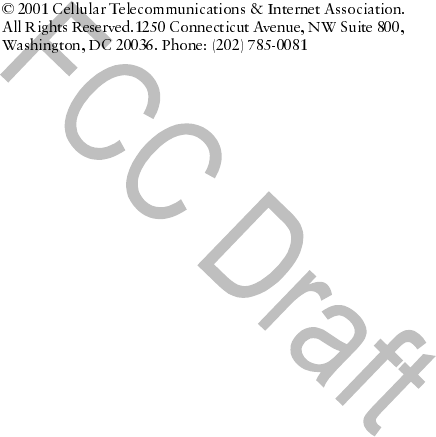
156 Copyright © Nokia 2003
Appendix A
Message from the CTIA
(Cellular Telecommunications
& Internet Association)
to all users of mobile phones.
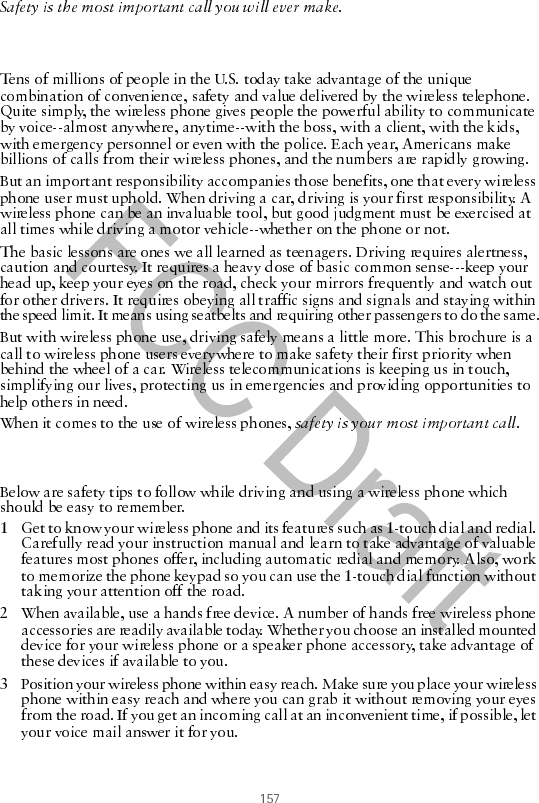
Nokia #### User Guide Copyright © Nokia 2003
Technical information (to be updated)
A Guide to Safe and Responsible Wireless Phone Use
Wireless Phone "Safety Tips"
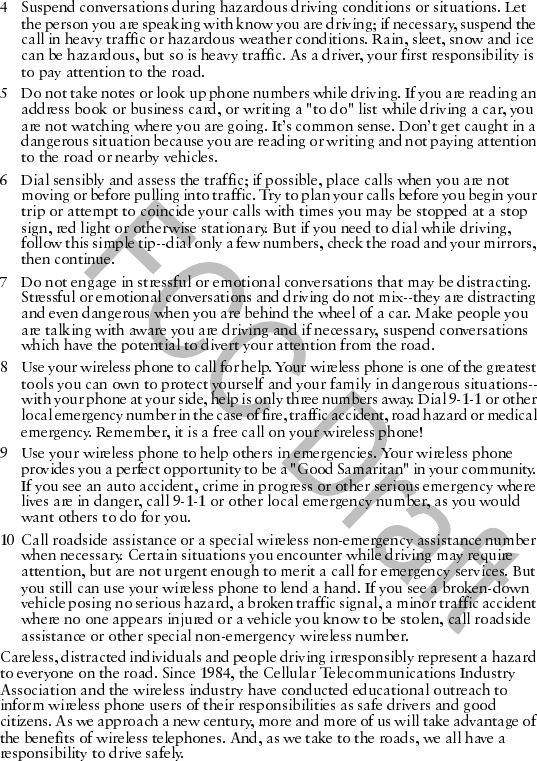
158 Copyright © Nokia 2003
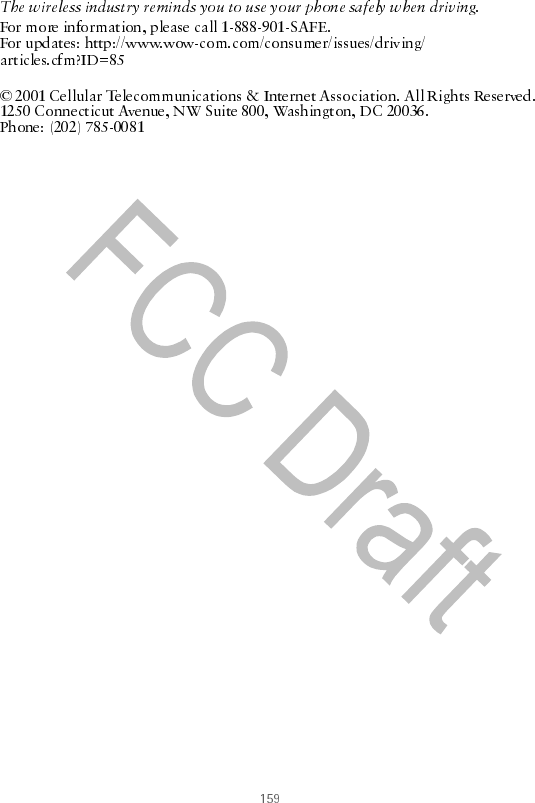
Nokia #### User Guide Copyright © Nokia 2003
Technical information (to be updated)

160 Copyright © Nokia 2003
Appendix B
Message from the FDA (U.S.
Food and Drug Administration)
to all users of mobile phones.
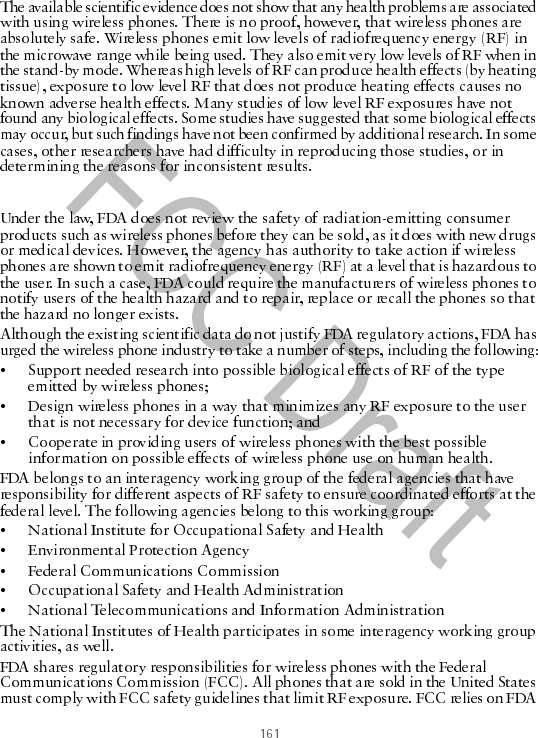
Nokia #### User Guide Copyright © Nokia 2003
Technical information (to be updated)
Consumer Update on Wireless Phones U.S. Food and Drug Administration
1. Do wireless phones pose a health hazard?
2. What is FDA’s role concerning the safety of wireless phones?

162 Copyright © Nokia 2003
3. What kinds of phones are the subject of this update?
4. What are the results of the research done already?
5. What research is needed to decide whether RF exposure from wireless phones
poses a health risk?
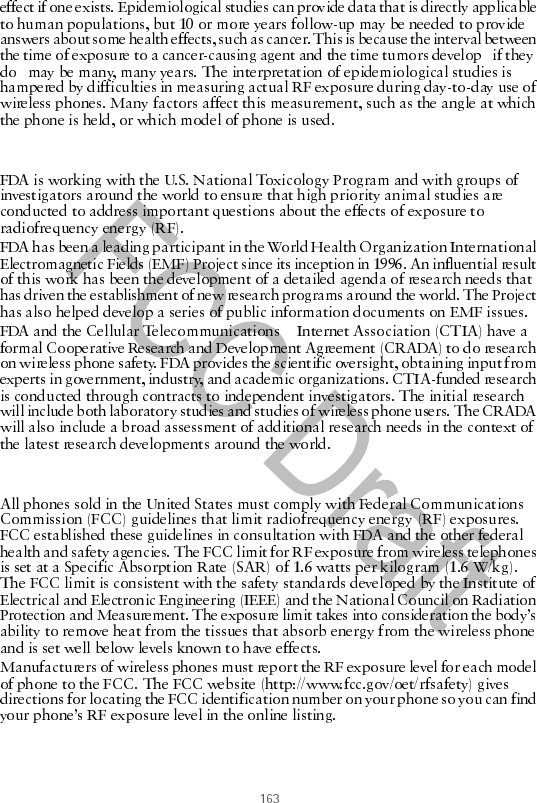
Nokia #### User Guide Copyright © Nokia 2003
Technical information (to be updated)
—
—
6.What is FDA doing to find out more about the possible health effects of wireless
phone RF?
&
7. How can I find out how much radiofrequency energy exposure I can get by using
my wireless phone?

164 Copyright © Nokia 2003
8. What has FDA done to measure the radiofrequency energy coming from wireless
phones?
9. What steps can I take to reduce my exposure to radiofrequency energy from my
wireless phone?
10. What about children using wireless phones?

Nokia #### User Guide Copyright © Nokia 2003
Technical information (to be updated)
11. What about wireless phone interference with medical equipment?
12. Where can I find additional information?
July 18, 2001 For updates: http://www.fda.gov/cdrh/phones

166 Copyright © Nokia 2003